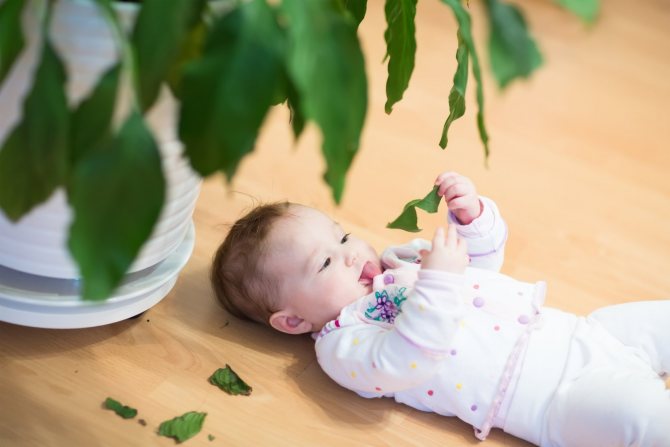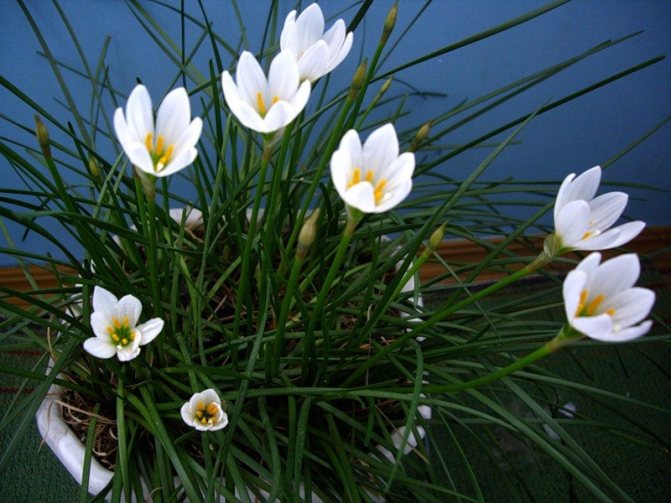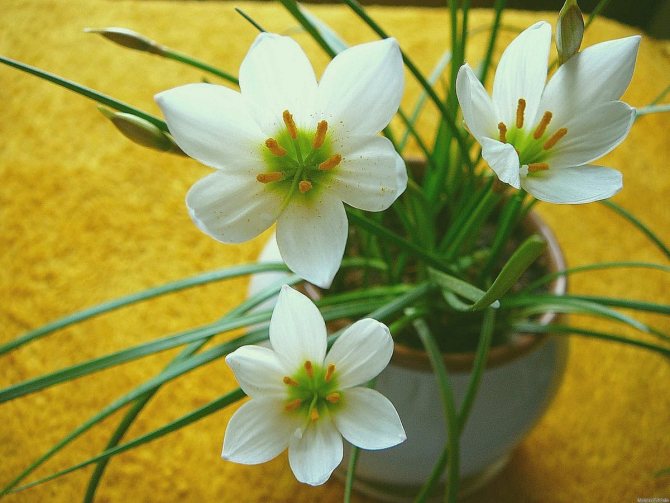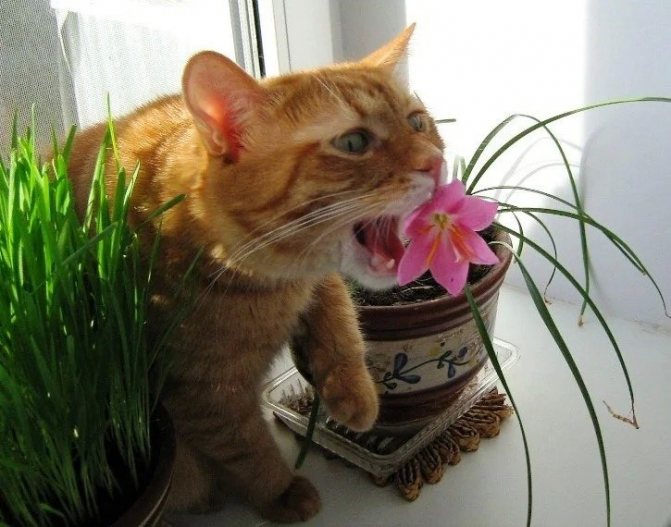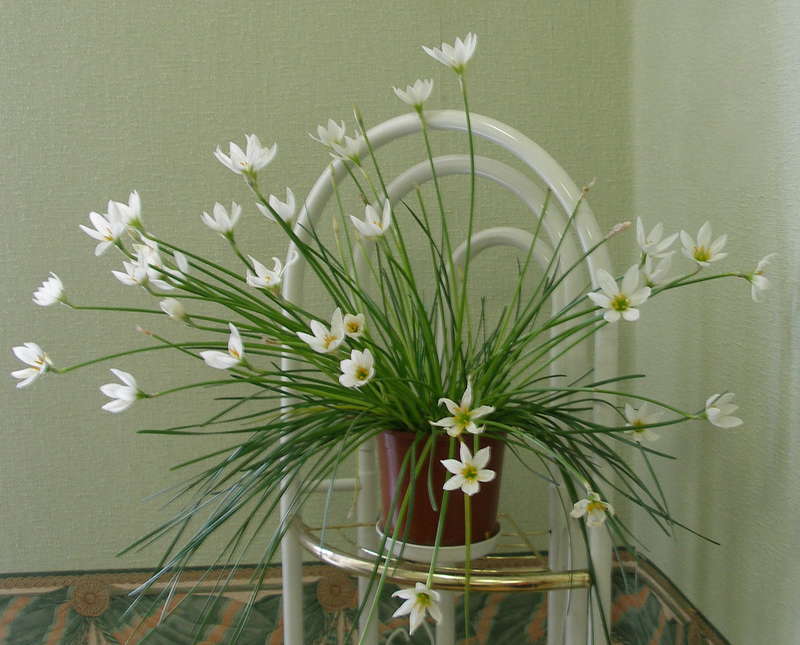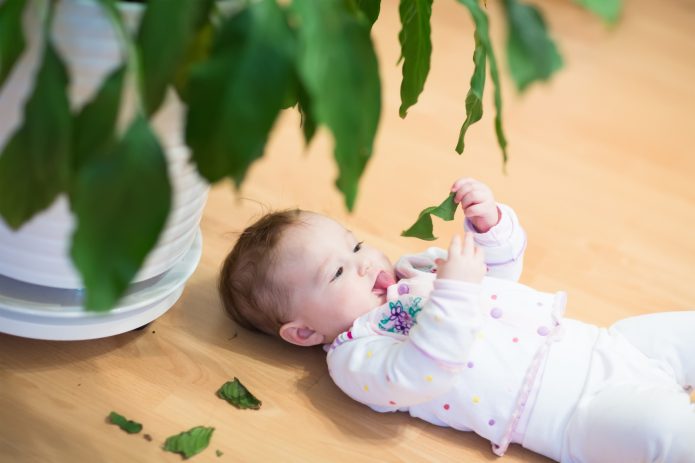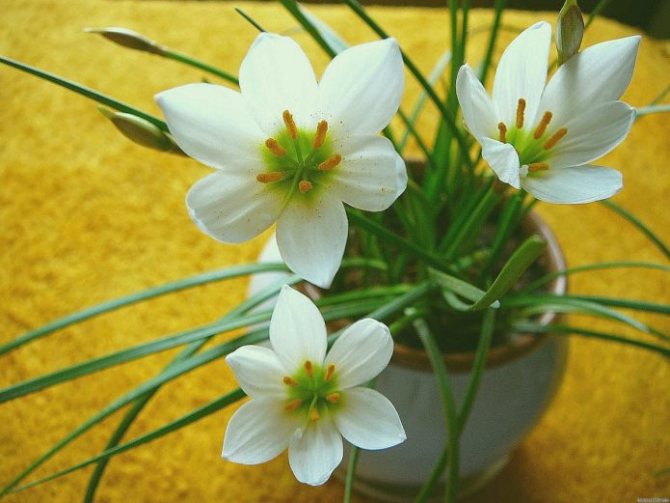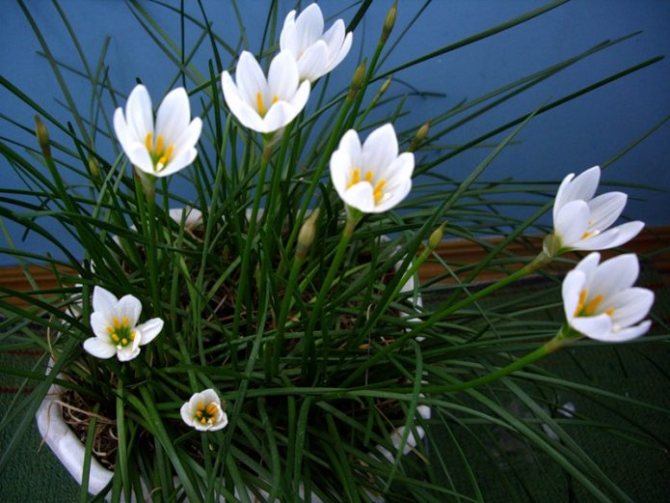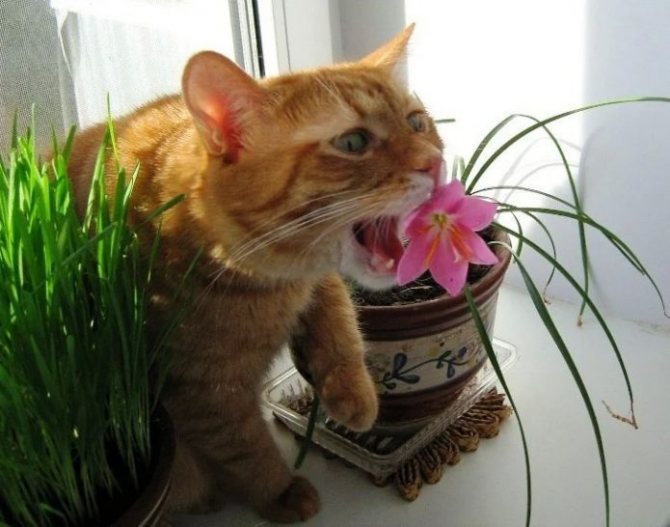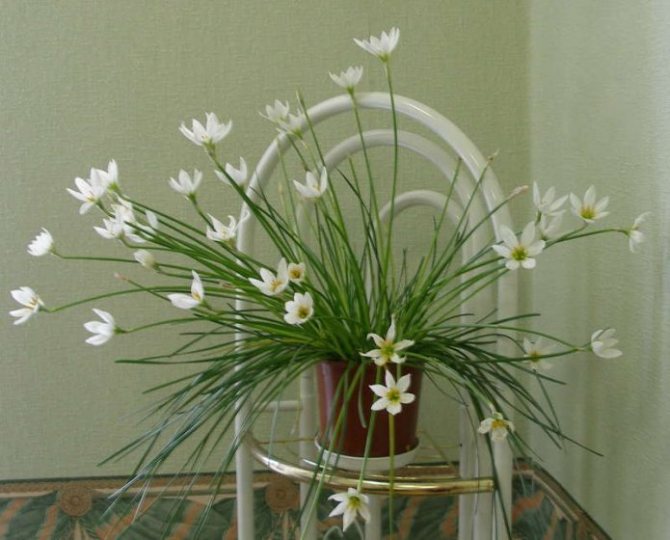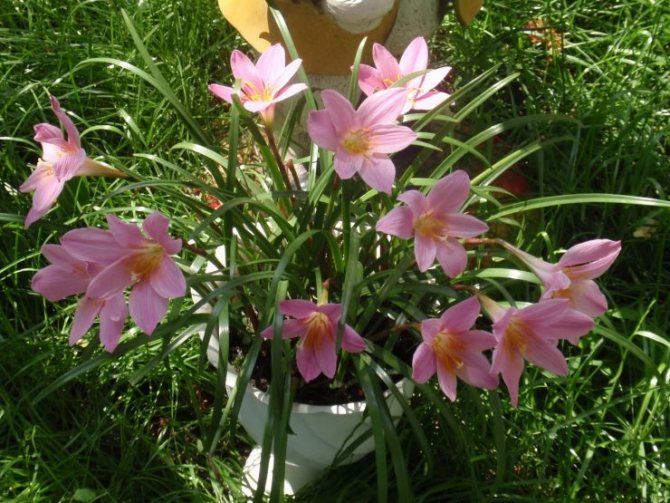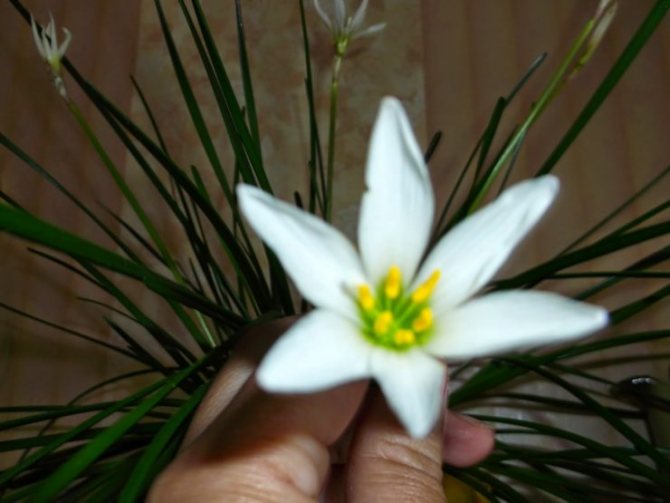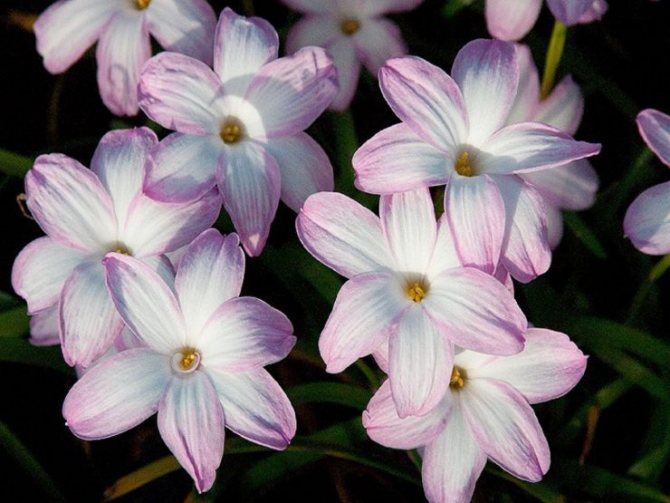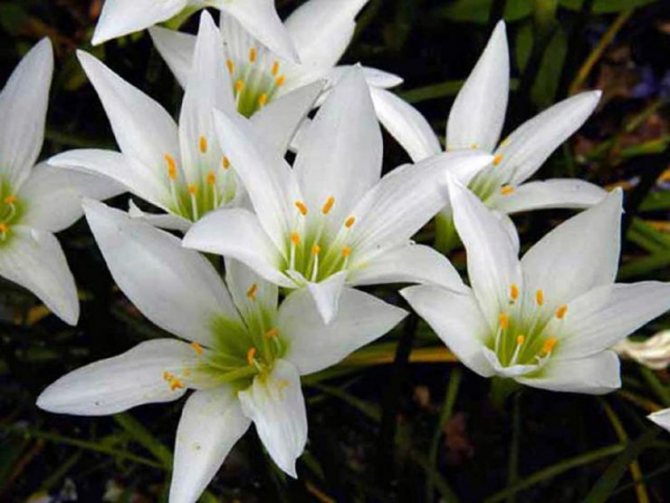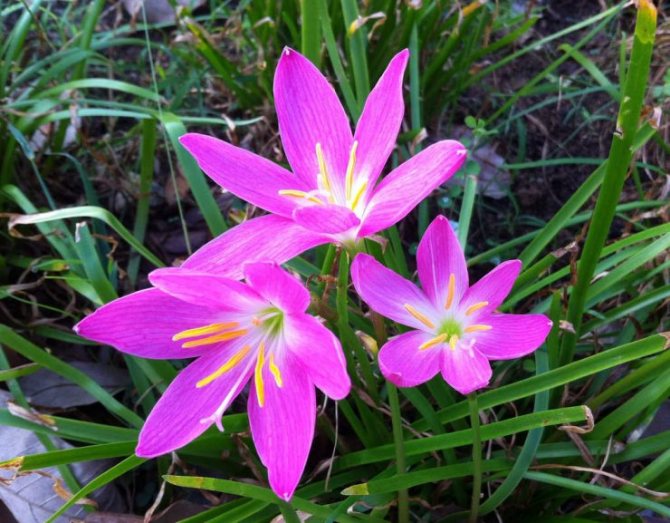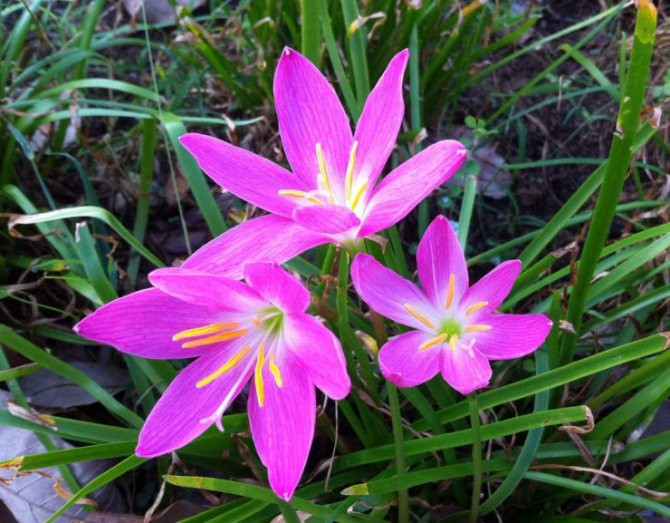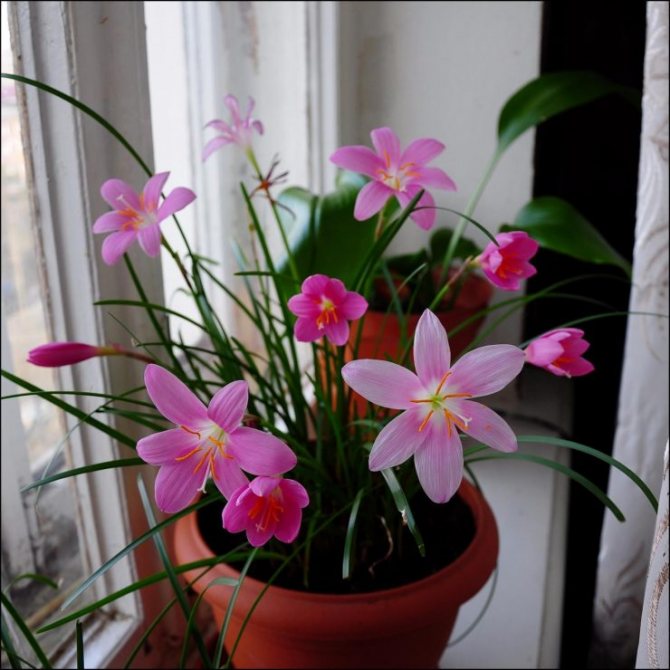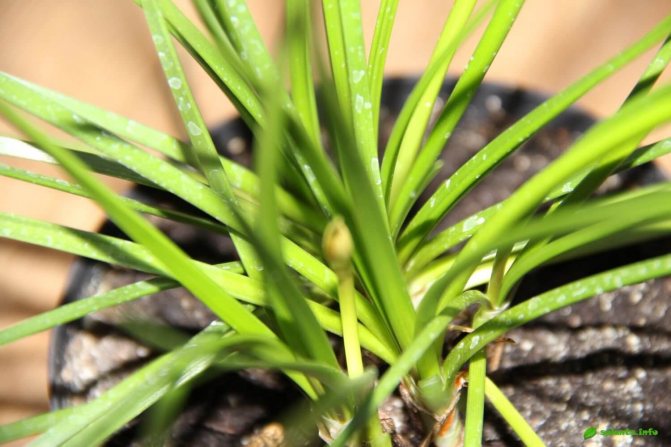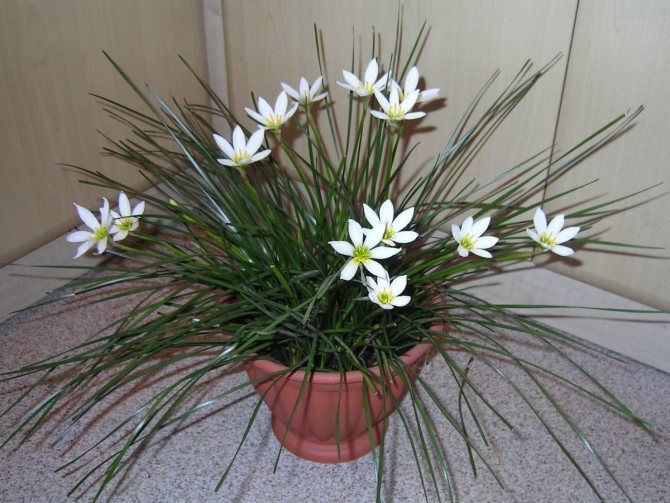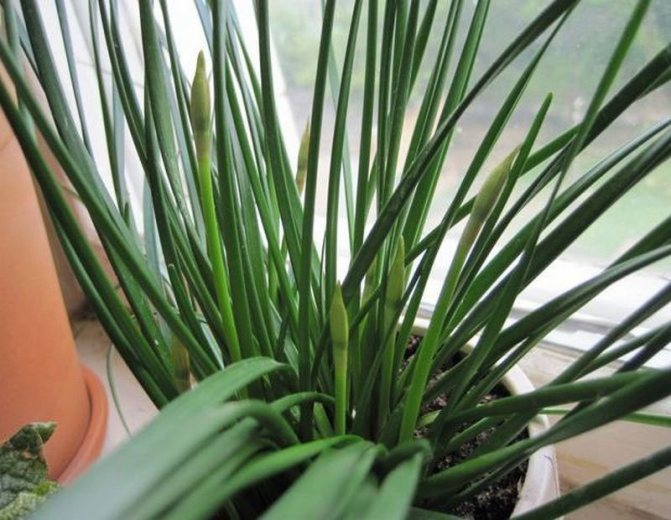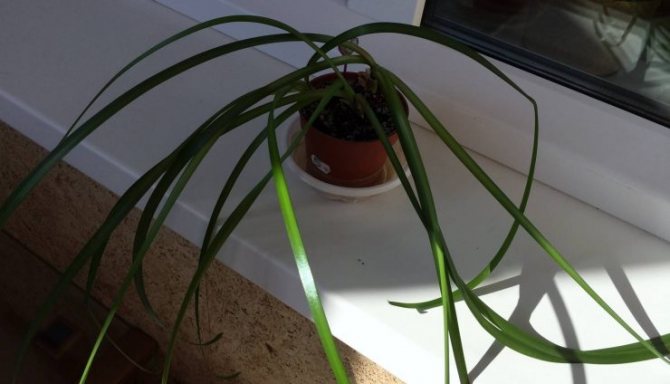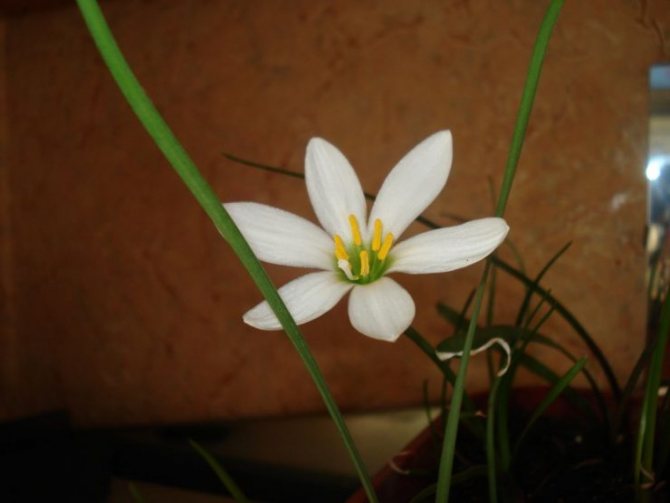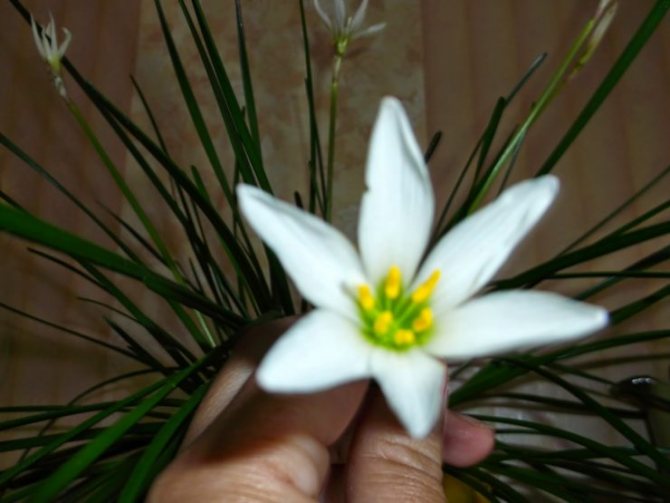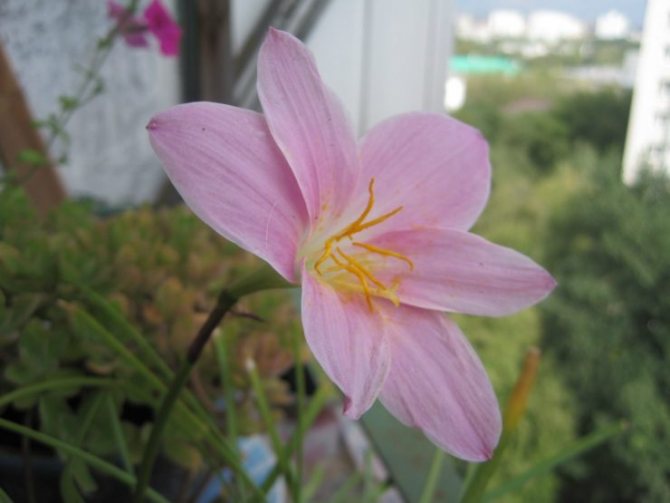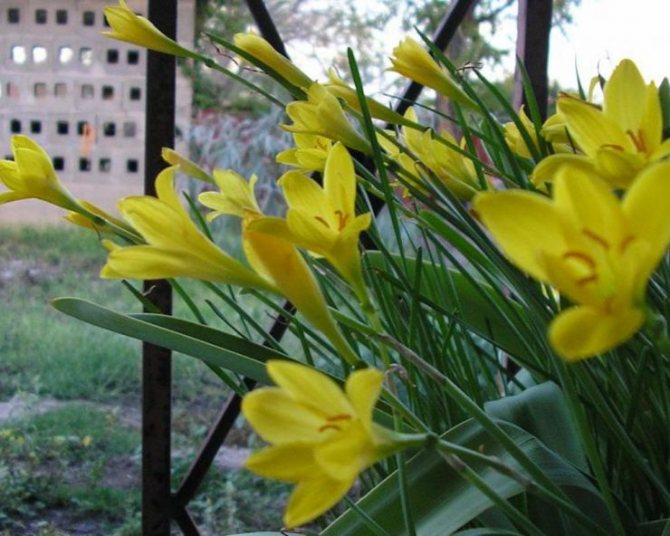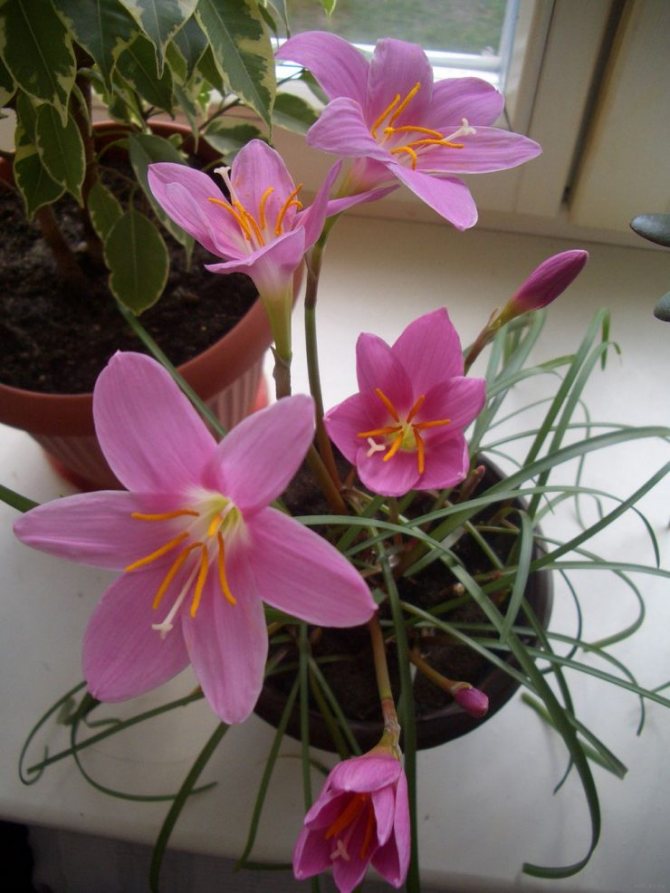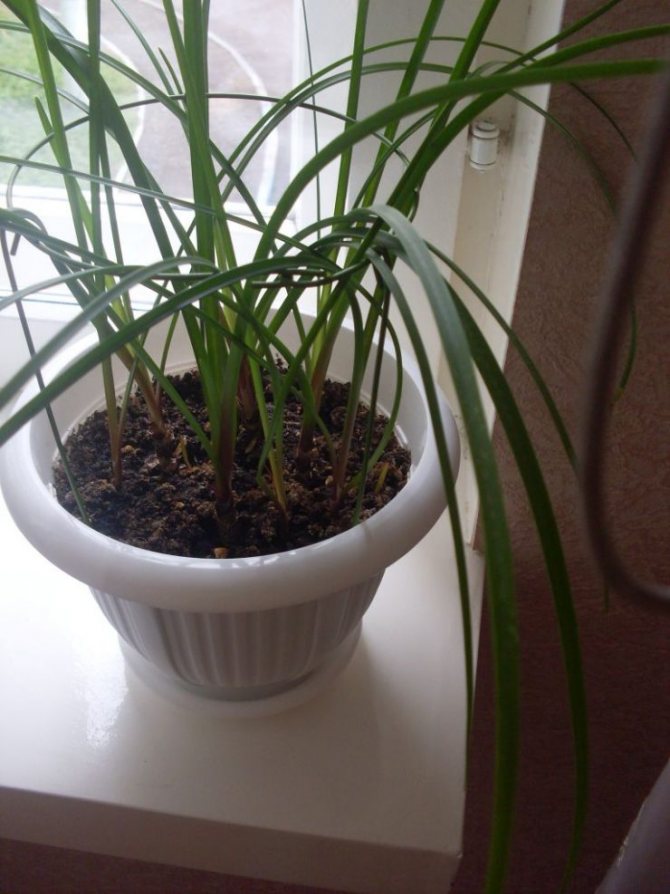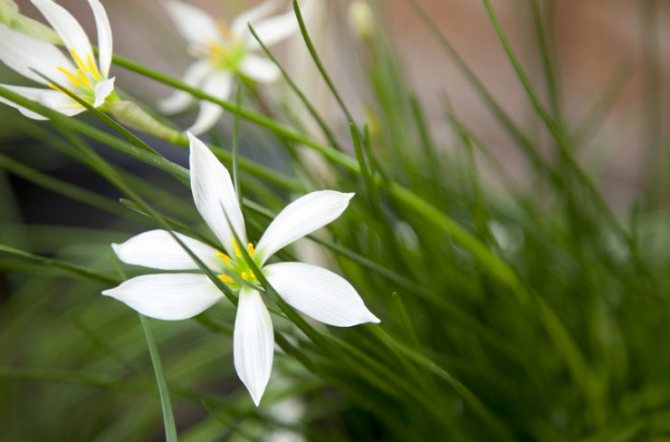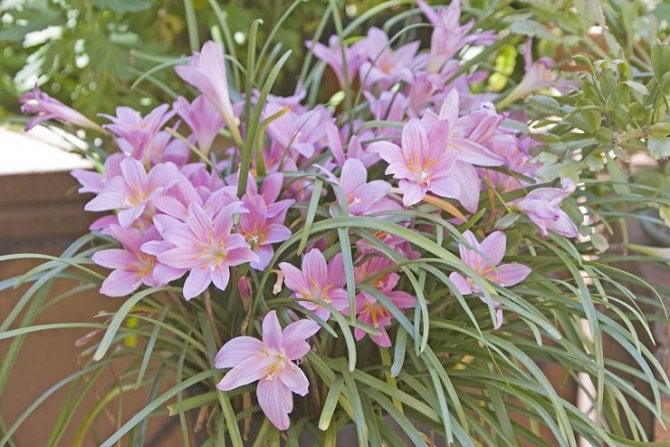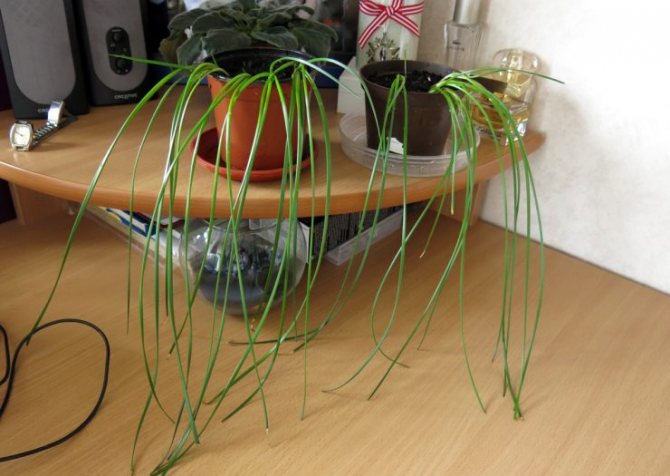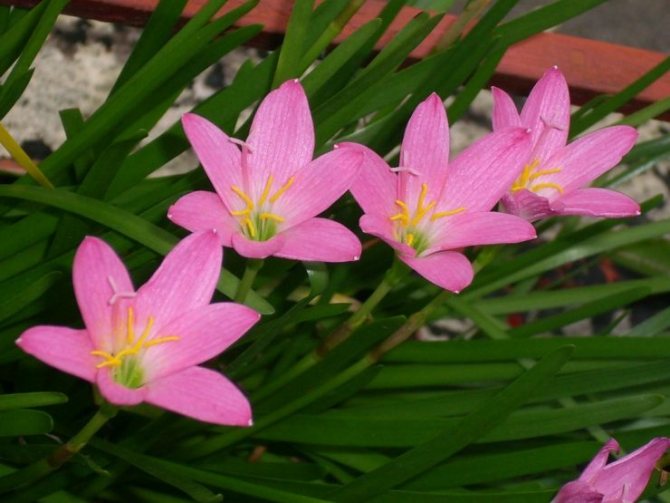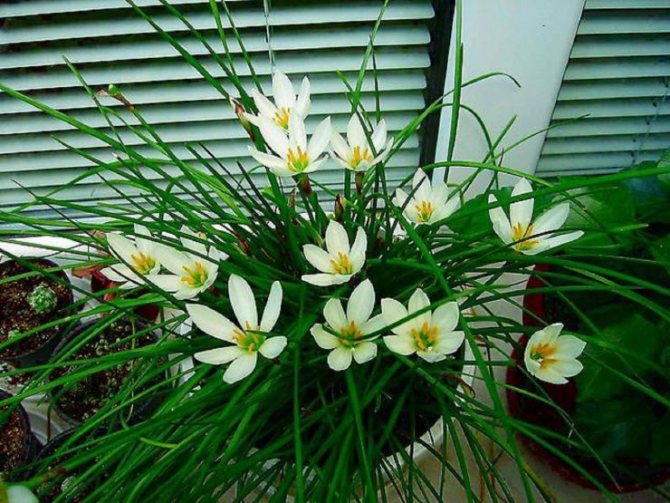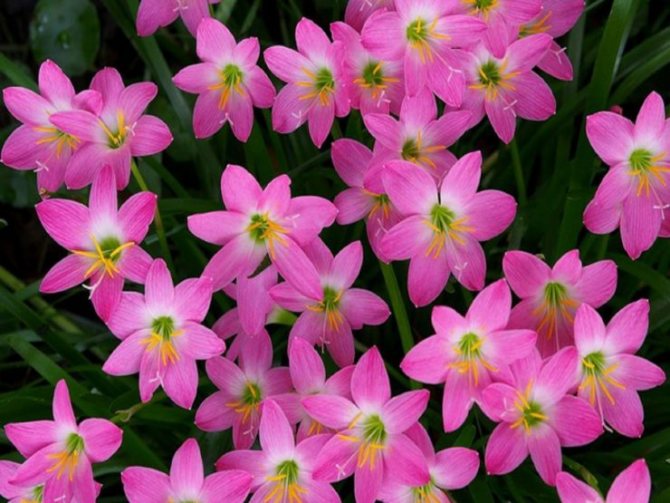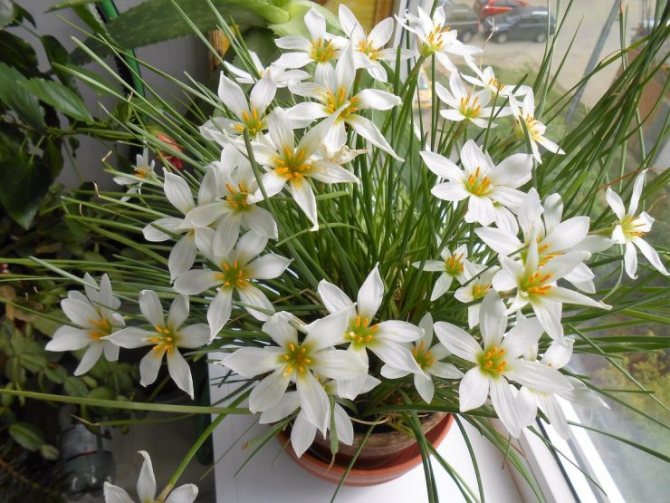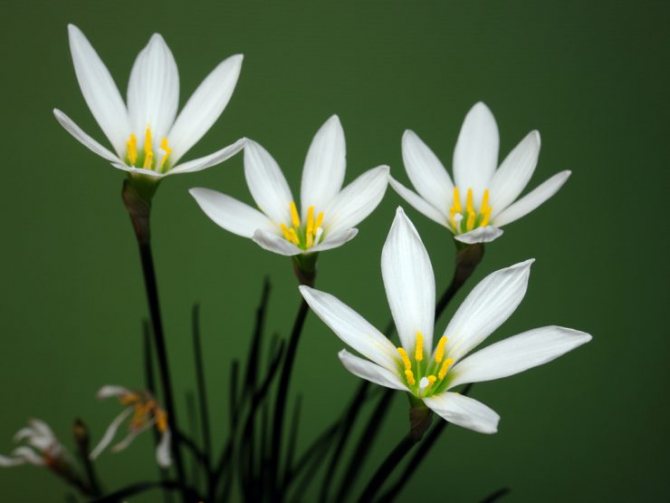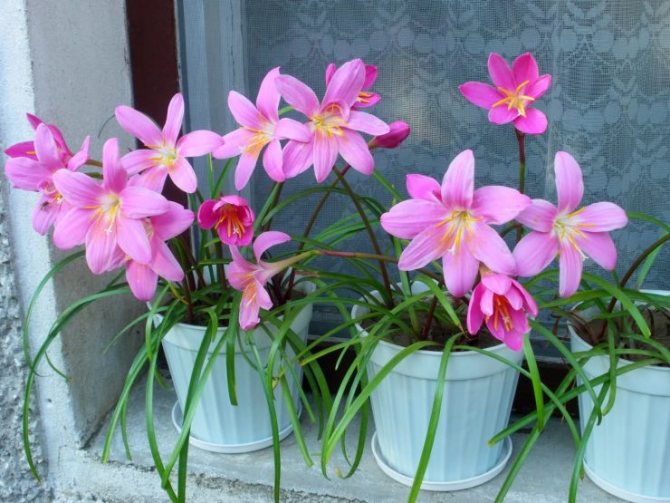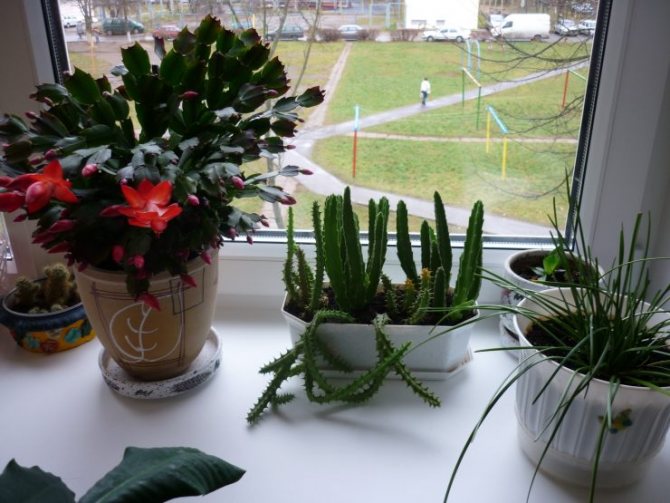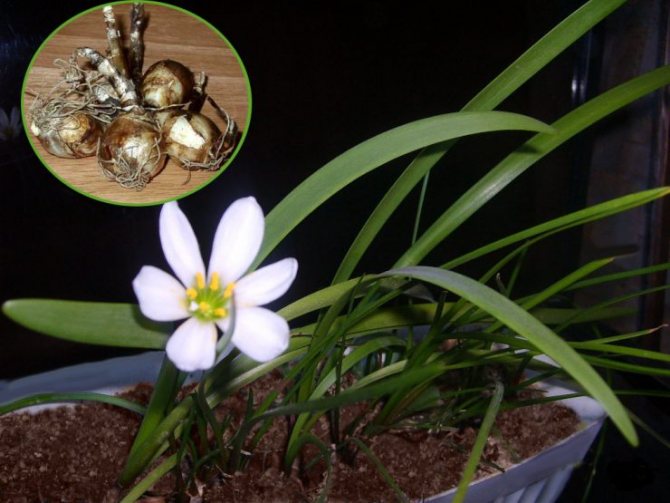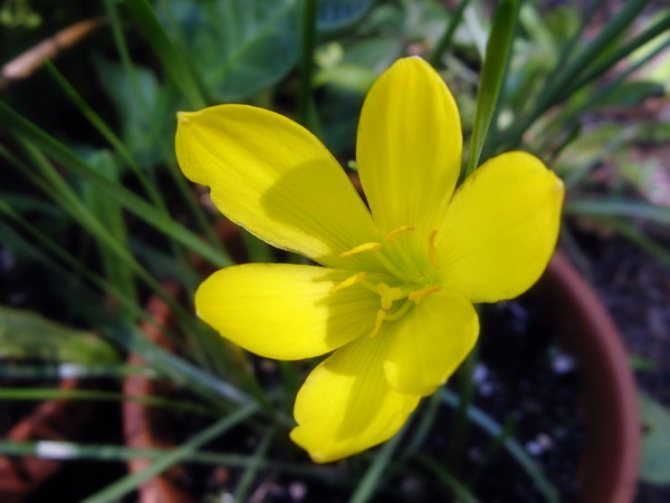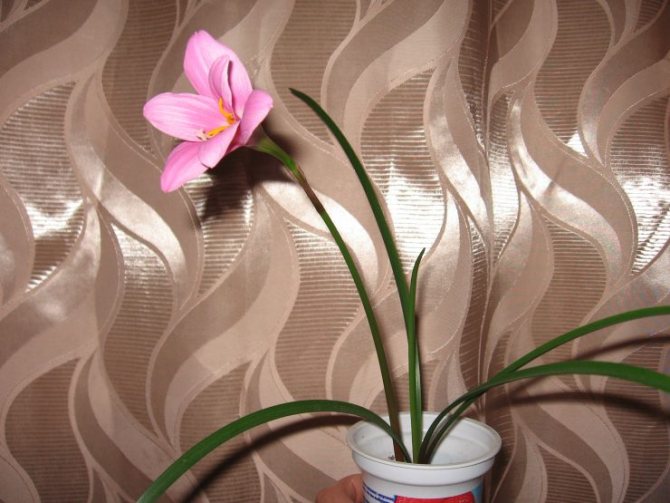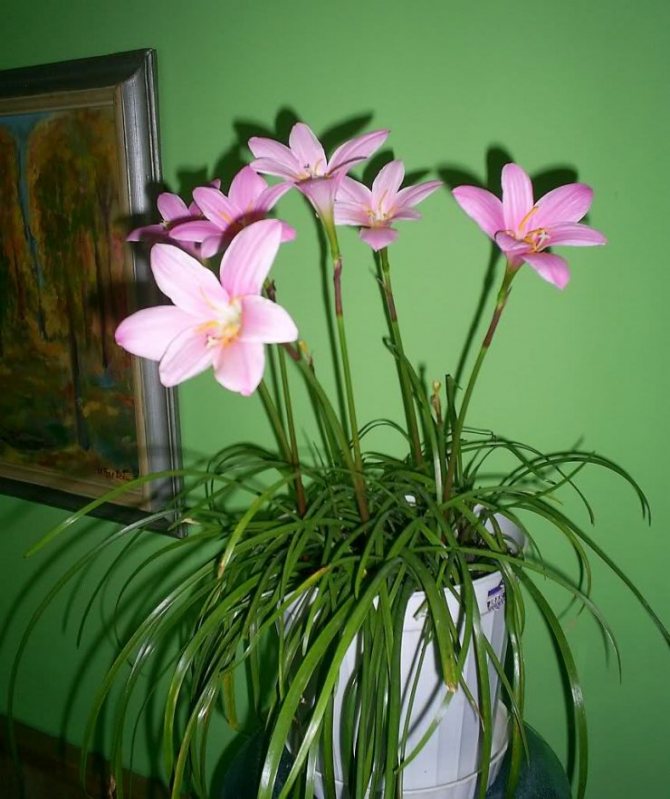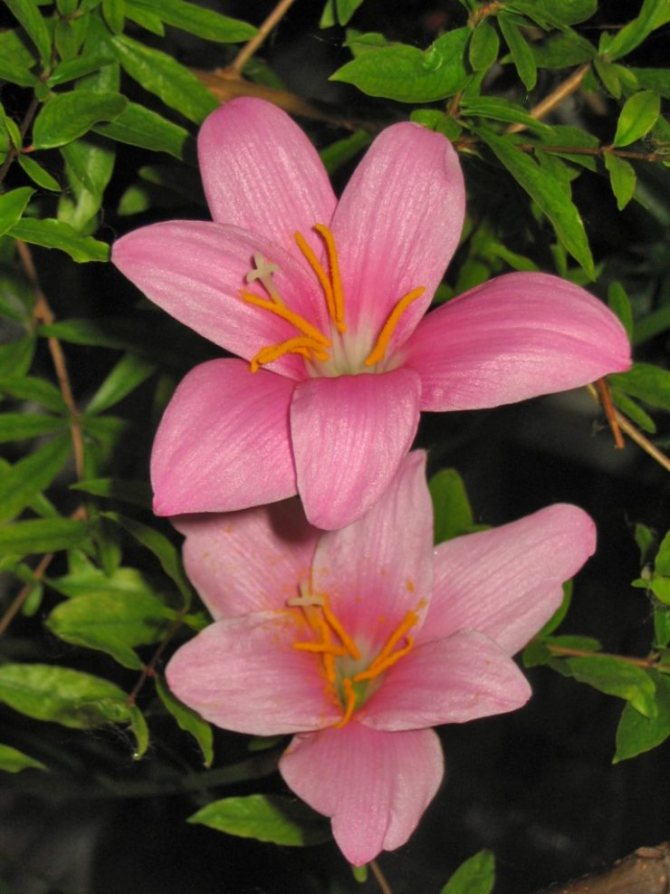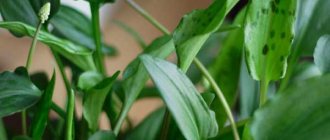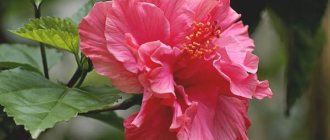Fairy lily, west wind flower, water lily, rain flower, indoor daffodil, upstart, zephyranthes - these are all names of one flower from the Amaryllis family. The flower comes from Central America. In the wild, it grows when the west wind (Marshmallow) begins to blow during the rainy season.

He was nicknamed "upstart" because it rapidly sprouts and begins to bloom. After its appearance, only a few days pass - and now white, lilac, two-color, red or golden flowers are already flaunting above the ground. There are over 40 plant species. Among gardeners and lovers of indoor floriculture, zephyranthus is always a success.
✔ 3. Lack of a dormant period.
Incorrect flower maintenance during dormancy, most likely in a warm and humid room, can also lead to the fact that the zephyranthes never bloom. The ideal conditions for "wintering" is a dry and cool room with a temperature of + 8- + 10 ° C. During the dormant period, the flower bud ripens.
Zephyranthes is capable of shedding its foliage during a dormant period. In this case, the bulbs must be kept dry, and if the leaves still remain on the plant, then it is rarely necessary to water it - as a rule, 1-2 times a month is enough.
Why Zephyranthes Doesn't Blossom
Sometimes you have to wait a long time for the indoor daffodil to bloom. The lack of flowering can be caused by various reasons:
- insufficient lighting;
- waterlogging of the soil;
- deepening the root collar;
- "Fattening" the bulb in a wide pot;
- increased air temperature during rest (in September - November or December - February);
- overdose of fertilizers.
If you eliminate the causes, you can see the beautiful bloom of zephyranthes. Due to frequent watering of the plant, the death of its root system can occur.
But all is not lost yet! If you take the bulb out of the soil, air dry it well, and then plant it in fresh soil and do not water it for several days, the flower will be saved.
Botanical characteristic
The plant is perennial, flowering, bulbous. Comes from the Amaryllis family. It has narrow herbaceous leaves of dark green color up to 40 cm in length. The peduncle is hollow, tubular, the height does not exceed 30 cm.The bulbs are rounded, less often oblong, the diameter does not exceed 3 cm.The flowering begins in April and, with appropriate care, can last until the end of summer:
- flowers - single, wide open;
- petals - pointed;
- the core is dotted with bright yellow anthers.
Flower types
According to various sources, from 40 to 100 species of zephyranthes are found in nature. On windowsills, they give a color of no more than 10-12. The most popular, according to reviews, are the white-flowered lilies of the fairies.
- Zephyranthes is snow-white. It blooms in July-October, feels comfortable in cool rooms with enough light. The petals are white on the inside, but have a slightly pinkish tint on the outside. Having a pointed shape, they reach 6 cm in length. Medium-sized bulbs with an elongated neck.
- Zephyranthes Atamassky. Blooms in March-April. Feels comfortable at low temperatures. The petals are lanceolate. The bulbs are small, elongated, the neck is slightly shortened.
- Zephyranthes golden.Blooms in December-January. On the territory of the southern regions, he feels comfortable in garden beds. It has a bright yellow flower cup, pointed towards the bottom. The bulbs are medium in size and round in shape.
- Zephyranthes pink (large-flowered). Blooms in April-May. The flowers are large, colored in pink shades. The bulbs are elongated, the neck is slightly shortened.
- Zephyranthes multicolored. Flowering begins in mid-winter and continues into the spring months. It easily takes root in a room where the air temperature does not exceed 20 ° C. The flowers are red with greenish veins on the outside and completely white on the inside. The bulbs are oblong, covered with a dark film.
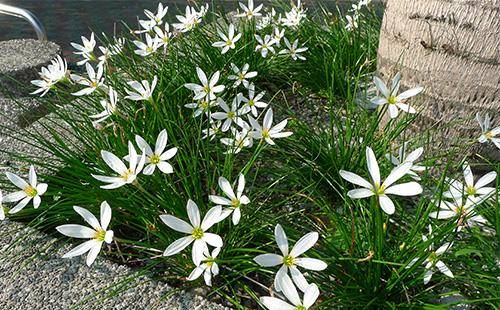

4. Varieties:
4.1 Zephyrantes whitish or Candida - Zephyrantes candida
Perennial delicate bulbous plants. Peduncles are leafless, do not exceed foliage in height, each carries a small white flower with 6 petals at the top, resembling a crocus, 3-5 cm in diameter.The leaves are dark green, very narrow and thin, up to 25 cm long.In their natural habitat, flowers are often appear in late summer or early autumn after long and heavy rains.
↑ Up,
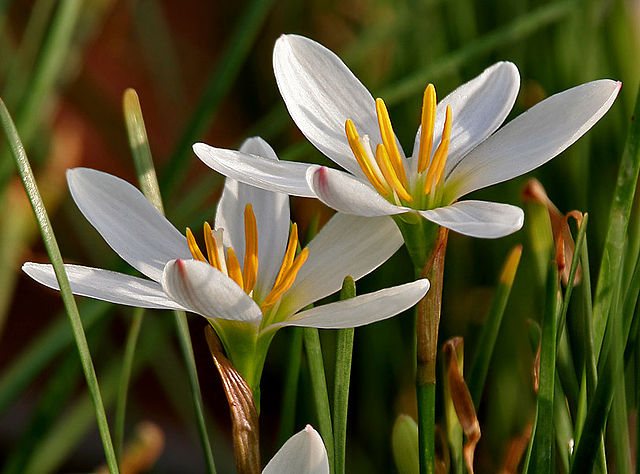

4.2 Zephyranthes robustus - Zephyranthes robusta, Habranthus robustus
Perennial bulbous plants with dark green, thin, glossy leaves. The flowers are pale pink, solitary, with a yellowish or green center, large - up to 5 - 7 cm in diameter, appear in August - September at the top of small leafless burgundy peduncles.
↑ Up,
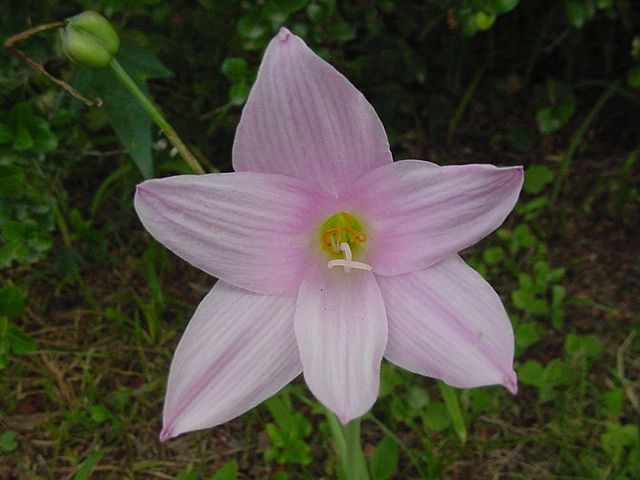

Zephyranthes: care and what conditions need to be created
In warm climates, the rain lily takes root easily in the open field and serves as a flower bed decoration for several months. But the practice of growing plants in pots is still more popular. The duration of the flowering of a plant largely depends on how you care for the marshmallow.
- Temperature. Compliance with the temperature regime during the growing season and dormancy does not allow the bulbs to rot. The optimum temperature for growth and development is between 18 and 25ºC. For rest, the plant needs lower temperatures - from 10 to 12 ºC. Airing the room or landing in open areas will create favorable conditions for active life.
- Lighting. A bright light is needed, which ensures abundant flowering and enlargement of the bulbs. Direct sunlight is permissible, does not have a detrimental effect on delicate fragile leaves. The rules for growing zephyranthes (upstart flower) at home allow the plant to be placed on the windowsills of any windows, with the exception of the north side. In summer, the pots are displayed on the balcony in the garden.
- Watering. Upstart bulbs are prone to rotting, therefore they are demanding for watering. The soil is moistened as the top layer dries up; settled water is used. Stagnation of liquid and complete drying out of the earthen coma are unacceptable. In rooms with low humidity, the leaves are regularly sprayed. When the active flowering phase is stopped and the plant enters a dormant state, watering must be reduced.
- Top dressing. An actively developing plant must be watered with liquid mineral stimulants at least once a week. Fertilizer contributes to the preservation of juicy tones and the duration of flowering.
Transplant features
It is necessary to transplant an upstart flower immediately after waking up. An ideal home would be a shallow flowerpot, in which several bulbs are planted at the same time. In this case, it must be remembered that the root collars should not be deepened into the soil, but rise above it by a few millimeters. The composition of the soil must contain the obligatory three components in equal proportions:
- sod land;
- humus;
- sand.
It is also necessary to take care of ensuring drainage.
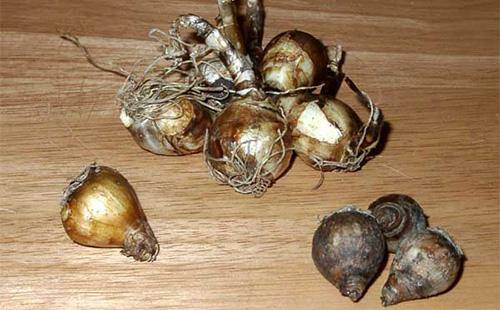

Increase in numbers
Reproduction of Zephyranthes (upstart flower) is carried out both by seeds and by newly formed bulbs. Planting and growing seeds is a laborious process, they rarely resort to its help. The seedling will bloom no earlier than in a few years, while the bulbs will bloom next year.
Zephyranthes in landscape design
With the help of zephyranthes, beautiful and unusual landscapes are created. In the middle lane, the flower is usually grown indoors, only taking it outside in the summer. Zephyranthes are often combined with planting other herbaceous plants to create beautiful flower beds.
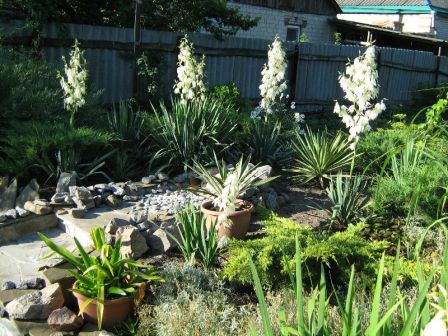

To do this, you can substitute a potted plant for flowers growing in a flower bed. The flower looks great in rockeries and alpine slides. It is planted along garden paths and curbs.
The flower, delicate and airy, as its name is, has not been perceived as an exotic plant for a long time. Grown in a summer cottage or at home on a windowsill, it can delight with exuberant long flowering several times a year.
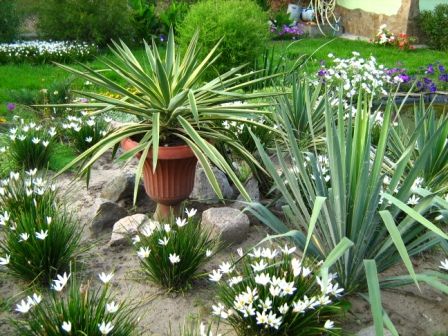

The whims of the fairies lilies
Like all the inhabitants of the flower beds on the windowsills, the fairy lily requires attention to its person. She expresses her dissatisfaction with the quality of care in her own way.
- The tips of the leaves dry out. Very often, amateur flower growers are faced with problems, as a result of which the leaves turn yellow and dry. This indicates violations of irrigation conditions, which led to decay of the root system. The plant can be cured by removing the infected parts of the plant, treating it with a fungicide and planting it in renewed soil.
- Flowers do not appear. The reason for which zephyranthes does not bloom must be sought in an incorrectly selected container. A deep pot contributes to the active growth of the root system, directing all forces in this direction. The smaller and wider the flowerpot, the more abundant the flowering will be.
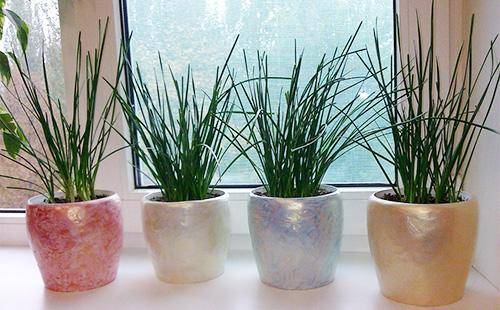

Healing properties
The flower has medicinal properties. Due to the content of naturally occurring bioactive alkaloids, Zephyranthes is a part of some medications. Traditional medicine uses the components of the plant to treat liver diseases, including some forms of hepatitis.
With the help of a flower, purulent accumulations resulting from inflammatory processes (abscesses) are eliminated. In some countries, the plant is included in medicines aimed at combating various forms of tuberculosis and diabetes. There is speculation about the antitumor properties of marshmallow leaves.
In folk medicine, infusions and decoctions of the plant are used to treat colds, abscesses and purulent tonsillitis. For colds, the flower is brewed like tea and taken orally. In case of sore throat, gargle with infusion of the plant. A medicine made from flower bulbs is applied to the abscesses on the skin.
It is unacceptable to use zephyranthes on its own for medicinal purposes, since all the components of this plant are poisonous. Improper use poses a threat to human health. To get competent advice on the use of a flower as a medicine, you should consult a homeopathic doctor.
Diseases and pests
Diseases tend to bypass the upstart. Only improper watering can negatively affect the condition of the bulbs. It is extremely rare for a plant to be attacked by fusarium (red rot). The disease is caused by a fungus that infects the bulb through small wounds and cracks. The diseased link must be separated along with a clod of earth and prevented from spreading. Healthy onions must be treated with Maxim or a weak solution of potassium permanganate.
Pests also infest the flower not often, but quite actively. Among the main enemies of the upstart are the following:
- amaryllis worms;
- spider mites;
- scabbards;
- whitefly.
The following table will tell you how to recognize and fix the problem.
Table - Insects that damage marshmallows, and how to deal with them
| Name of the pest | Appearance, features | Diagnostics | Ways to fight |
| Amaryllis bugs | - Small; - transparent white; - feed on the pulp of bulbs | - Yellowing, wilting, falling leaves; - growth arrest | - Remove heavily damaged bulbs; - treat the remaining insecticides; - follow the rules of watering (do not overfill) |
| Spider mites | - Small; - appear in conditions of low humidity and dry air; - can lead to drying out, death of the plant | - The appearance of cobwebs on leaves and stems | - Wash the affected areas with soapy water; - rinse the leaves and stems with warm water; - in case of abundant infestation, treat with an insecticide "Antimite" |
| Shields | - Small; - feed on plant sap; - have a characteristic shield on the back to resist the effects of insecticides | - Small brown plaques appear on leaves and stems; - leaves, stems, buds dry out, lose color | - With a cotton swab dipped in Aktellik solution (Aktara, Karbofos, Decis), wipe all the affected areas; - process the window sill, the outer part of the pot; - conduct an inspection after a few days and, if necessary, repeat the processing procedure |
| Whitefly | - Small, like moths; - live on the lower part of leaves and shoots; - greenish larvae feed on sap from leaves, leaving waste products on the surface | - Leaves turn yellow, fall off; - if you shake the pot, a swarm of insects will rise into the air | - Reduce watering frequency; - feed the soil with fertilizers; - move the pot to a well-ventilated place; - treat with permethrin-containing preparations ("Actellik") |
You will fully understand how to care for Zephyranthes in a pot only when faced with a number of its features. Indoor lily will delight with its flowering in winter and summer, subject to simple instructions. Sun, air and water are the three main ingredients for a successful Zyphiranthes bloom.
Pest control
Zephyranthes is quite resistant to pests, but under adverse conditions it can be attacked by insects.
Prevention and control of harmful insects - table
| Pests | Problems and symptoms | Methods for prevention and control |
| Shield | Dark plaques are visible on the leaf blades. Leaves and flowers fade and dry. | Treat the leaves with a solution of Actellik. |
| Whitefly | Small insect. The larvae settle on the inside of the leaf plate, sucking out the sap of the plant. Leaves fall. |
|
| Amaryllis bug | Whitish small insects infect the bulb. In damaged plants, growth slows down. |
|
| Spider mite | The pest enmeshes the leaves with cobwebs, the flowers dry. |
|
Insect pests in the photo
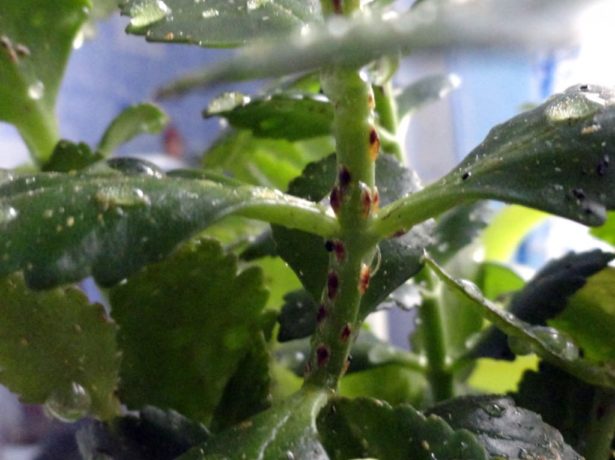

Shield is a difficult problem for a florist
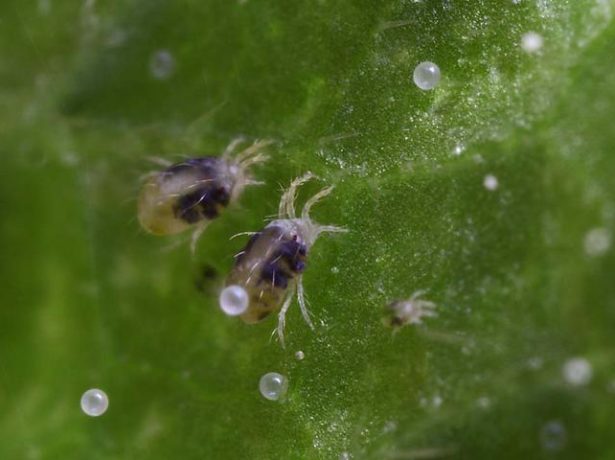

Spider mite entangles leaves with cobwebs
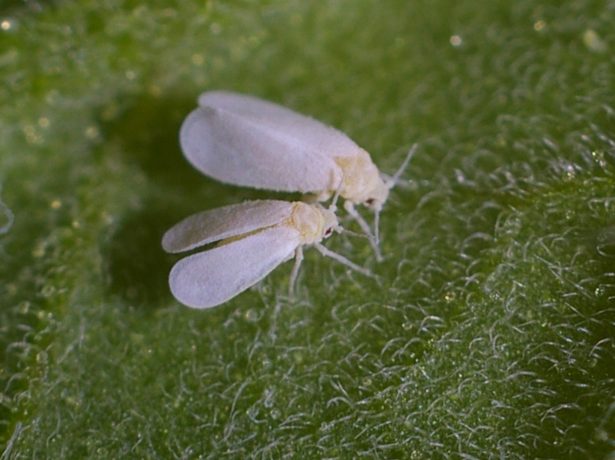

Entire colonies of whiteflies can settle on Zephyranthes
Reviews: “Why upstart? You don't expect flowers, but they, bam, have blossomed! "
I have been growing this flower for about 10 years. He amazes me with his unpretentiousness and endurance. I call it indoor daffodil. Bulbous plant. I rarely transplant it once every 3-5 years, when there will be little space for the bulbs in the pot. I tried to grow on the site. Bloomed all summer, and left for the winter in the ground did not survive. But I threw the bulbs dug out in the fall, and they lay in the paper in the closet for more than six months.When I found them, half of them dried up, but there were also those that I planted and they went to grow. Plant care is minimal, watering as the soil dries up and 1-2 times a month I arrange a shower. I did not notice pests and diseases on it. The height of the plant is about 30 cm. We often leave in the summer for several weeks and there is always a problem of how to preserve indoor plants, and with these I never worry. I poured it before leaving and forgot. Of course, upon arrival, my flower is half dry. I clean it, water it and again my flower continues to grow. And he survives thanks to the accumulated nutrients in the bulb.
Elrol, https://otzyv.expert/takoy-neprihotliviy-i-zhivuchiy-2110042
A friend gave me this indoor flower ten years ago, just a few bulbs. I had no idea that in a year I would already have a flower that resembles a bouquet of beautiful snow-white crocuses. Florists also call this plant a home daffodil, a water lily for its snow-white flowers. The plant did not require special care, just watering. Since there was not enough space on the windowsill, I moved the flower to the upper shelf in the children's room, but this did not affect the growth of this flower, it did not cease to delight with its flowering for a long time. Encouraging this behavior of the flower, I planted its bulbs, which further influenced the lush growth and abundant flowering. I have not yet met such flowers, so that with a minimum of care, such growth and continuous flowering. Every year, when the bulbs were planted, the number of flowers of this plant increased. I also planted this plant in my summer cottage. Such free conditions for the growth of the bulbs further contributed to the abundant long flowering.
At first, zephyranthes did not evoke any emotions in me - he grew himself like a rather rare grass in a pot on a working windowsill. But as soon as the plant bloomed, he charmed me! The people call this indoor bulbous flower "upstart". This is due to the fact that quite unexpectedly and suddenly a peduncle appears among the foliage, which just grows before our eyes! It literally only takes one day for a flower to fully grow a peduncle! Amazing! Zephyranthes' flowers are insanely delicate both in color and in appearance - they look like stars. Flowers can be painted in white, yellow or pale pink shades. There are many flowers at the same time, so the feeling of a blooming meadow is created: as if lovely flowers suddenly grew among the grass. The character of the upstart manifests itself in this plant in such a way that you never expect flowers, but - bam! - they have already blossomed)) A very unpredictable plant, and therefore interesting. In addition, it is completely undemanding to care for: he needs a lot of light, the temperature is suitable for the average room temperature. The soil only needs to be always kept moist, but not flooded, otherwise the onions will rot. That's all the care!
Why does Zephyranthes not bloom?
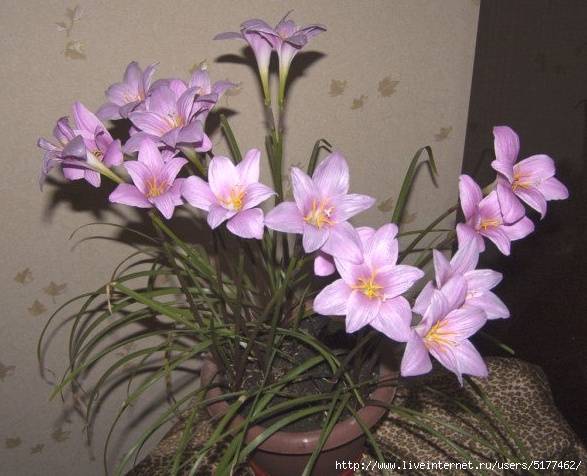

Zephyranthes is a beautiful delicate plant of the Amaryllis family. The birthplace of zephyranthes is considered to be Central and South America, where it is also called a small hippeastrum.
Zephyranthes is an ornamental flower of medium height that blooms annually with a single bud. It is unpretentious, but with regular care it can please for a long time with fast reproduction and beautiful flowering.
With proper care, zephyranthes blooms for 4–5 months a year, depending on the species, in autumn, spring or even winter. However, many growers face a problem when the marshmallow does not bloom.
There are a number of reasons leading to the fact that marshmallows do not bloom and do not please their owners with sophisticated flowers:
1. A small number of bulbs planted in one pot.
Zephyranthes does not bloom alone. The most common problem with rare blooming marshmallows is a small number of bulbs planted in one pot. It has been observed that 5-6 bulbs planted together give regular and more abundant flowering.
2. Incorrect fertilizing with fertilizers.
Improper fertilizing with fertilizers can also cause marshmallows not to bloom. It is optimal to use only mineral fertilizers and no more than 2 times a month. Fertilizers for flowering plants are suitable for feeding.
3. Lack of a dormant period.
Incorrect flower maintenance during dormancy, most likely in a warm and humid room, can also lead to the fact that the zephyranthes never bloom. The ideal conditions for "wintering" is a dry and cool room with a temperature of + 8- + 10 ° C. During the dormant period, the flower bud ripens.
Zephyranthes is capable of shedding its foliage during a dormant period. In this case, the bulbs must be kept dry, and if the leaves still remain on the plant, then it is rarely necessary to water it - as a rule, 1-2 times a month is enough.
4. The pot is too big.
Zephyranthes are rarely transplanted - only when the dishes are completely filled with lateral processes-children. The new pot shouldn't be too spacious.
5. Deep landing.
The bulbs must be planted with the neck of the plant on the surface.
6. Insufficient lighting.
The flower feels better on the south, west and east windows. It can grow on the northern window, but it can be difficult to achieve flowering.
7. To make the upstart bloom, it is necessary to arrange for him a period of drought, and then water - this can provoke the appearance of flower arrows.
If in warm seasons you have the opportunity to place zephyranthes on a balcony, veranda, or even in open ground, then this will benefit him. It can bloom on the street.
At first, Gabrantus belonged to the genus Zephyranthes, but since there are enough differences between these plants, it was singled out as a separate genus. Zephyranthes and gabrantus belong to the amarylissa family. Varieties According to the color of the flowers, there are 4 types: White-flowered. The bulb is 2-3 cm in diameter, the leaves are narrow, the flowers are white, about 6 cm in diameter. Feels good in cool rooms. Blooms in May-September. Bulb with a diameter of 3 cm, funnel-shaped flowers, yellow. It grows well outdoors in the Central and Central Chernozem regions. It blooms in December-January on a windowsill, in May in the open field. The flower is 8 cm in diameter, the bulb is 3 cm in size. It blooms in April-July. Bicolored. The bulb is elongated, 3 cm, with a dark outer film. The flowers are usually white, outside they are reddish-green. Blooms in January. Suitable for moderately warm rooms. Zephyranthes is successfully cultivated in our country both indoors and in the garden. Grows outdoors in the subtropical regions of Russia, namely in the Krasnodar Territory. The plant is unpretentious, develops well, requires minimal maintenance. Any novice florist can handle it. At home, all types of zephyranthes grow equally well, but on the windowsills you can most often see the popular indoor varieties described below: Zephyranthes candida. Belongs to the white-flowered group. The bulb reaches a size of 3 cm. The leaves of the snow-white Zephyranthes appear together with the peduncle. Its flowering period is from July to October. Great for cool to moderately warm (22-25 ° C). Zephyranthes aurea. This plant belongs to the yellow-flowered group. Its bulb is round, yellow flowers are funnel-shaped at the base, then expand. Blooms from December to January. Zephyranthes golden is very popular for planting in open ground in areas with a warm climate. We have him a welcome guest on the windowsills. Pink Zephyranthes, or pink (Zephyranthes rosea). One of the most popular varieties. Belongs to the red-flowered species, has very bright purple-pink flowers. Zephyranthes robusta. Its name speaks for itself.The bulb reaches 4 cm. The flowers are large, the length of their light pink petals can reach 7 cm. It blooms in April - July. The dormant period is pronounced and runs from September to November. Red-flowered group Zephyranthes versicolor. Zephyranthes multicolored belongs to the bicolor group. A bulb with a diameter of 3 cm has a dark outer film. The flowers are reddish outside, creamy white inside. The length of the petals is 5-6 cm. It blooms in January. Of course, there are much more varieties of zephyranthes: out of 90 existing in nature, about 10 are grown at home. Planting and transplanting Planting and transplanting zephyranthes is best done in the spring, after a dormant period. The bulbs must be pretreated: free from dead scales, remove rotten or dry roots, place in a fungicide, for example, Fitosporin, for half an hour. The capacity for this plant must be chosen wide, but shallow. As a rule, several bulbs are planted in one bowl. The soil should be loose and nutritious, and the pH should not exceed 6. When preparing the substrate, it is best to mix turf, sand and humus in equal parts. Drainage is laid out on the bottom of the pot. The drainage layer should be at least two centimeters. Small expanded clay, brick chips, polystyrene foam are suitable for this purpose, and eggshells will be appropriate if the soil pH is lower. Then the bowl is half filled with the prepared substrate. The bulbs are placed at a distance of 3 cm from each other, the roots are gently straightened. The onions need to be covered with the substrate along the neck.
Preparation before planting zephyranthes
Zephyranthes is an exotic thermophilic plant that grows naturally in subtropical and tropical climates, so it is quite difficult to grow them in temperate climates. It is important to carry out thorough preparation, choose the most suitable variety of zephyranthes for the garden, purchase planting material or grow it yourself. Only after observing all the rules can you achieve beautiful and constantly blooming flowers of zephyranthes.
Stage 1. Selection of varieties and seedlings of zephyranthes for open ground
- In our temperate climate, zephyranthes are most often grown at home, and in open ground they are planted only in the summer. However, in the warmer southern regions, some varieties of this plant can still be grown in a garden or flower garden.
- For temperate climates, the use of large-flowered and pink marshmallows is suitable, which are distinguished by an early flowering period.
- If you are going to plant zephyranthes in open ground only for the summer season to obtain abundant flowering, then you can buy zephyranthes of any popular variety.
- Next, it is important to purchase high-quality planting material. If you buy bulbs in garden stores, you can get too overdried planting material that can germinate and bloom in about 3-4 years. It is best to buy bulbs planted in pots, bonsai plants.
- It is best to buy planting material in specialized garden centers or nurseries that are professionally engaged in plant breeding. Here you will receive a guarantee of the purchase of high-quality bulbs and advice on growing a particular variety in the open field.
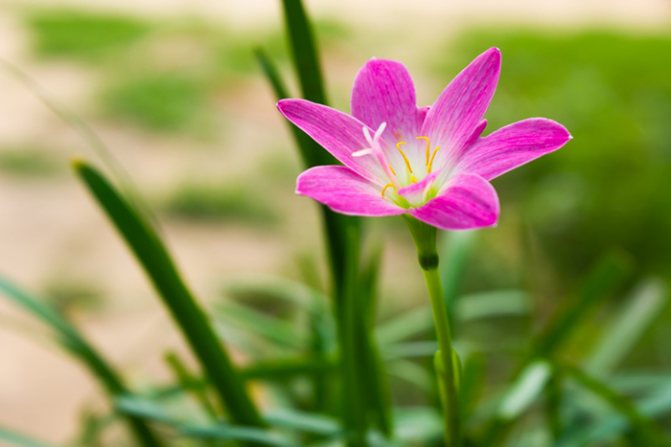

Stage 2. Choosing a place and soil for planting zephyranthes
- Zephyranthes prefers to grow in an open, sunny place where there is sufficient sunlight.
- This plant can be planted in flower beds or flower beds, they look great in rock gardens and rockeries.
- It is preferable to plant the zephyranthes bulbs in slightly elevated places so that moisture does not linger in the area of the bulbs.
- This exotic flower loves to grow in nutritious and fertile soils.
- The soil must be very light and friable and allow moisture and air to pass through well.
Types of Zephyranthes
In our area, 6 types of zephyranthes are most widespread:
- Zephyranthes snow-white, or white (Zephyrantes candida), differs in white pointed petals on peduncles up to 20 cm tall. The bulb is round in shape and reaches a diameter of 3 cm. Flowering begins in mid-summer and continues until October.
- Atamas (Zephyrantes atamasca) prefers cool rooms and flowers from March to April. Bulbs up to 2 cm, ovoid, leaves are long, narrow, dark green in color, white flowers, 3-4 cm in length.
- Zephyranthes robustus, or powerful (Zephyrantes robusta), is distinguished by light pink flowers, reaching 6 cm. The bulb is 4 cm in diameter. Blooms from April to July. One of the largest representatives of the species, native to Brazil and Argentina.
- Golden (Zephyrantes aurea) has thin, long leaves reaching 30 cm, blooms yellow from the beginning of winter to February. Prefers cool rooms.
- Large-flowered (Zephyrantes grandiflora) has an ovoid bulb up to 3 cm in diameter, grooved leaves up to 30 cm high and 0.5-0.7 cm wide. It blooms from April to July. For this variety, it is important to observe a dormant period from September to February, when they stop watering it, cut off the leaves and put it in a cold room, such as a cellar or refrigerator, for the winter.
- Multicolored (Zephyrantes versicolor) differs in that the peduncles appear before the leaves, and the flowers have a beautiful color - white on top, and inside and outside, near the peduncle, red-green. It blooms in January and also loves coolness.
Exemplarily gentle and elegant zephyranthes
Representatives of the Zephyranthes genus, grown as cultivated plants, did not accidentally get their name from marshmallow - the west wind (translated from Greek, the name of the plant sounds like "flower of the west wind"). Zephyranthes is gentle, surprisingly delicate, and at the same time perceived in the interior as a breath of fresh air, a flower. The plant looks like a radiant bouquet, fully justifying such a comparison.
The upstart visually places surprisingly fresh, clean accents, as if giving rest to the soul and eyes. Zephyranthes' purity and simplicity are truly unmatched. Even against the background of other indoor bulbs - both rare and more popular - it still seems special. Popular nicknames of the plant fully reflect its beauty - lily of fairies, lily of rain, flower of rain, marshmallow lily, flower-marshmallow and simply "marshmallow".
This representative of the Amaryllis family has rather small bulbs, and the plant itself is not impressive in size. Zephyranthes leaves are glossy, fleshy and flat, belt-like or linear, 25 to 40 cm long.
Zephyranthes are plants that amaze with the speed of peduncle development. Actually, for the almost “instantaneous” growth of flowering shoots, they received the popular nickname “upstarts”. From the moment it appears above the soil surface to flowering, it takes only 2-3 days. Unlike many bulbous competitors, it is not inflorescences that bloom on the peduncles of the zephyranthes, but single flowers. Funnel-shaped, lily-like or crocuses-like, stellate, they reach 2-8 cm in diameter. Unfortunately, the flowering of each flower occurs as quickly as the appearance - they last only about 2 days.
The flowering period of zephyranthes differs from plant to plant: it can bloom in winter, spring and summer.
The color range of zephyranthes includes pink, white, yellow in the purest varieties.
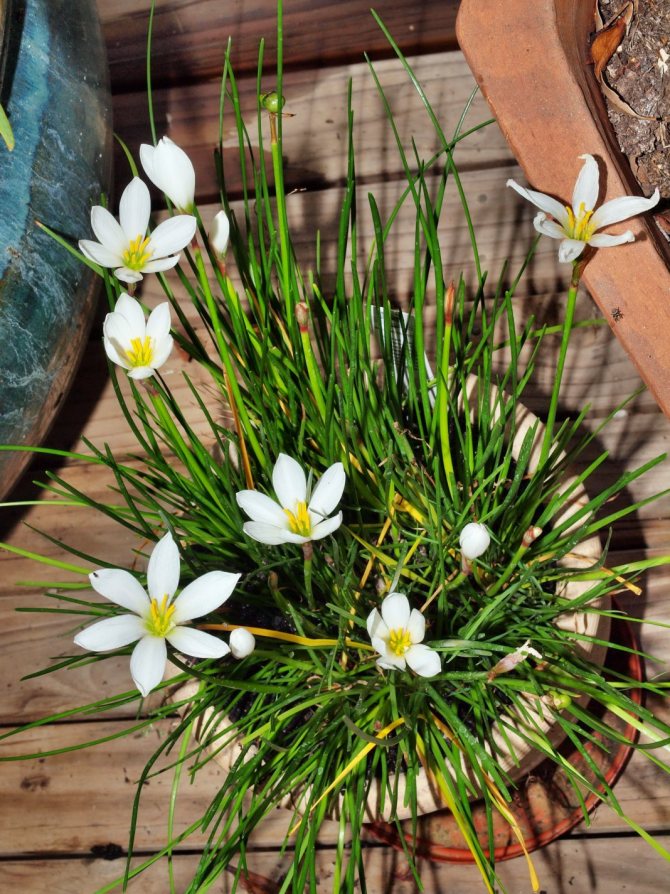

Zephyranthes. <>
Optimal growing conditions in the house
Despite its unpretentiousness, the plant will be healthy and blooming profusely while fulfilling very simple requirements for lighting and temperature conditions.
Lighting
The flower during the growing season and flowering will be grateful for the bright sunlight diffused light. In summer, you can safely land it on the balcony or in open ground. And in the room, choose the lightest window for it: south, west or east. But there are species that shed their leaves for the winter and need rest, therefore they are placed in a dark room until spring.
Temperature
Zephyranthes is considered an undemanding home care plant, and the air temperature is the same as for humans.
The optimum temperature in summer is 19-24 ° C, and during the rest period it is enough 10-12 ° C, but here it is important not to overdo it and not to drop the temperature below 5 ° C, otherwise the plant will die.
How to propagate and transplant a flower at home
Zephyranthes very quickly fills the space of the pot, so it needs to be transplanted annually. To increase the aesthetic quality of the plant, several bulbs are placed in one pot. Thus, during flowering, wilted inflorescences are replaced by new ones. Some growers place assorted marshmallows in one container.
There are two ways to propagate a plant at home: by seeds and bulbs. Further, in detail about each method of breeding new zephyranthes.
Seed propagation
Upstart propagation by seeds involves the following steps:
- Artificial pollination. Using a cotton swab, pollen is transferred from one flower to another.
- Seed collection. Seeds are considered mature 2 months after the pollination process.
- Disembarkation. The collected seeds are immediately planted in the substrate due to the rapid loss of germination. You can use the substrate for an adult Zephyranthes. Above the container with seeds is covered with a transparent film, imitating a greenhouse.
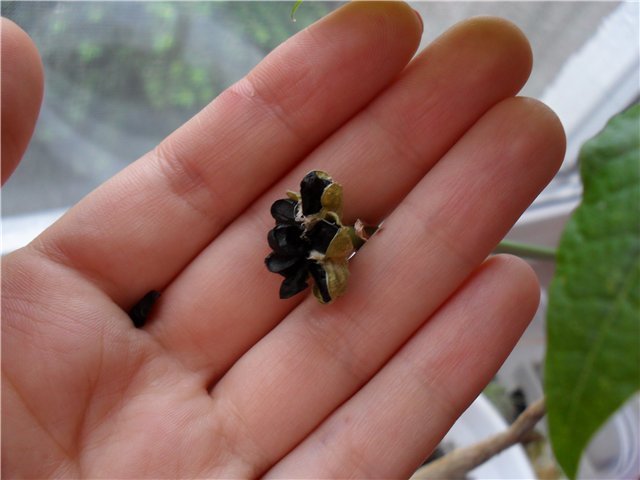

Zephyranthes seeds - Daily care. Seedlings are irrigated daily from a spray bottle and briefly left without a film for airing. After 2-3 weeks, the first shoots will appear.
- Picking. Young upstarts dive only when 2-3 good leaves appear on them.
Flowers taken from seeds bloom only in the third year of life.
Bulbs
Propagating upstarts with bulbs is easy. The process involves the following actions:
- Without effort, the daughter bulbs are separated from the mother. The bulbs should come off easily. If they hold on tightly, it means that they are not yet ready for an independent life.
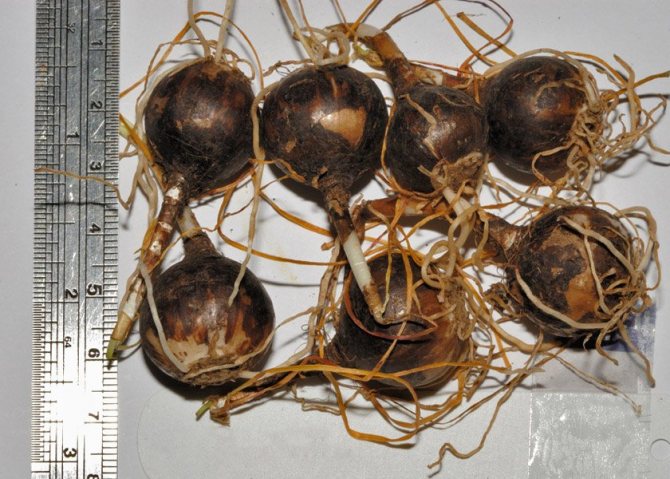

Bulbs - Fracture points are lubricated with crushed activated charcoal or charcoal.
- The separated bulbs are planted in the soil mixture, leaving the necks on the surface.
Important!
Experts recommend propagating the upstart in a bulbous way before or after the dormant period of the flower. It is impossible to disturb the plant bulbs during the flowering period.
Features of home care
One of the main reasons for the wilting and lack of growth of marshmallows can be improper watering or lack of fertilization. Therefore, it is important to know exactly how to care for a flower.
Watering
The plant loves abundant watering in the summer, and during the growing season and flowering. But you do not need to fill it and allow moisture to stagnate in the pot.
Water the flower when the soil in the pot is a little dry. In winter and during the dormant period, watering is stopped completely to avoid rotting of the bulbs, and begin in spring, or at the end of February, when new leaves appear.
Top dressing
During the growing season and flowering period, zephyranthes are fed with liquid universal fertilizer every 2 weeks according to the dosages indicated by the manufacturer.
Plant care
Lighting
Like all tropical plants, a zephyranthes needs a lot of light, and it also tolerates direct sunlight. For cultivation, east and west windows are suitable. In the summer, the upstart can be sent to the balcony. Some gardeners plant zephyranthes in an open flower bed in the country for the summer.
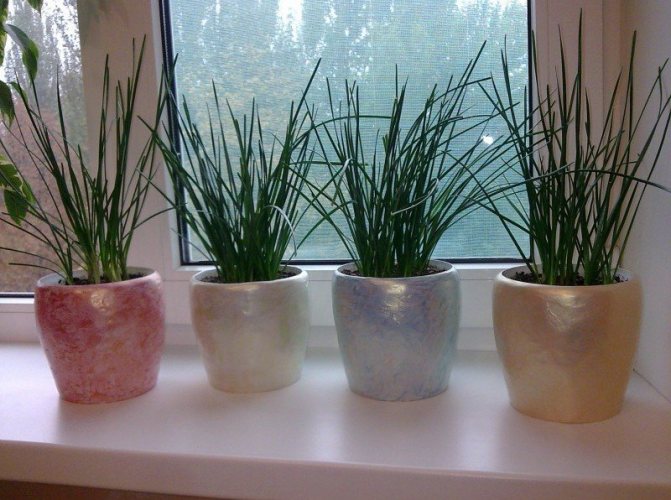

Zephyranthes loves the sun, so a window sill is the right place for him
Temperature and watering
The optimum temperature for the proper development of zephyranthes is + 20 ... + 26 ° С. It's summer. In winter, depending on the species, the marshmallow drops or leaves the leaves. In the first case, it must be removed to a dark and cool place with a temperature of + 8 ... + 14 ° C (the basement or the lower shelf of the refrigerator will do). It is sometimes necessary to moisten the ground so that the bulbs do not dry out. When new leaves appear, the marshmallows are put back.
If the plant does not shed its leaves, then it is left in a bright place, but it should still be cool (about +16 ° C). Watering is rarely done.
The winter time, when the flower does not grow, is called the dormant period. It begins in most varieties of upstart in September - October, lasts at least 2 months, more often up to six months.
In summer, the flower is watered often and abundantly. The frequency and volume of water depends on the degree of drying of the soil. It should be remembered that zephyranthes does not tolerate waterlogging and even more stagnant water. In addition to watering, spraying is needed - once every 2 days. Water for procedures is soft, kept for at least 6 hours.
Top dressing
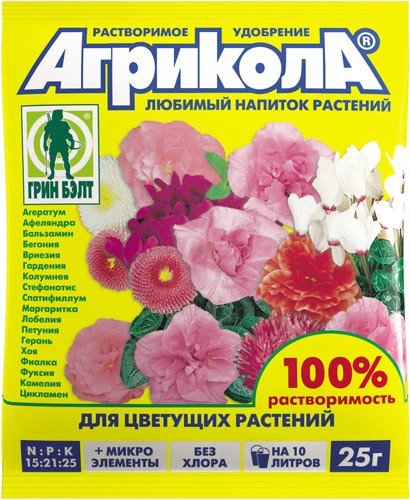

Complex fertilizers for flowering plants are suitable for Zephyranthes
Zephyranthes responds favorably to feeding. They need to be carried out every 10 days during the active season - from the emergence of sprouts in the pot until the end of flowering. Liquid flower fertilizers with a mineral complex (Merry Flower Girl, Kemira-Lux, Agricola) are suitable for this. Organic fertilizers can also be used, but with caution (for example, unripe manure will lead to rotting of the bulb). Ash contains many elements necessary for the plant. A nutrient solution can be prepared by adding 1 tbsp. a spoonful of ash in 1 liter of water.
Fertilization rules for indoor flowers:
- an oversupply of fertilizer for indoor plants is just as harmful as a shortage;
- plants absorb fertilizers well only in the active phase of growth and flowering;
- in the winter period, feeding should be rare due to low natural light, due to which the absorption of nutrients is slowed down;
- you should not carry out top dressing even in a sultry time;
- do not allow the fertilizer solution to hit the foliage;
- for young flowers, the concentration of fertilizer should be weaker than for already rooted ones;
- you cannot fertilize the plants without thoroughly watering the soil, if this is not done, you can burn the roots.
Bloom
From May to October, Zephyranthes pleases with flowers. They live only a few days, but since there are many peduncles, the effect of a long flowering is created. After its end, the leaves die off, and a dormant period begins. It's time to transplant Zephyranthes.
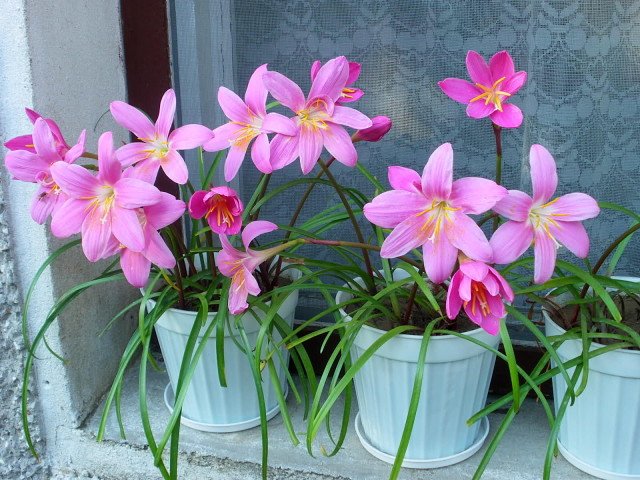

Although a single zephyranthes flower does not live long, due to the abundance of peduncles, the effect of continuous flowering is created.
Dormant period
In one of the autumn months, the growth of the plant stops, the leaves dry, begin to fall off. A dormant period begins. Watering at this time should be stopped, and the pot should be placed in a dark cool place (+ 8 ... + 14 ° С). At the same time, the bulbs remain in the ground; dry leaves must be removed. Zephyranthes "hibernation" lasts about 3 months. When new young leaves appear, the plant is returned to normal conditions and care is resumed.
Florist errors
If the plant develops slowly and does not please with flowers, then, perhaps, mistakes in agricultural technology were made. To stimulate the growth of zephyranthes and make the upstart bloom, it is necessary to correct the mistakes made. Why is the plant sick?
Problems in the care of zephyranthes and how to solve them - table
| Problem | Cause | Decision |
| The plant does not bloom | Warm and wet wintering | Provide other wintering conditions - with optimal temperature and watering. |
| Little light | Rearrange to a brighter place. | |
| Excess fertilizer | Suspend feeding. | |
| Deep landing | Transplant or break up the soil around the bulb. | |
| Pot too tight for roots | Transplant the plant into a larger pot. | |
| Rotting bulbs | A lot of water in the ground | Reduce watering, if necessary, transplant the upstart into new soil. |
| Leaves turn pale | Little light | Move the flower pot to a bright place. |
| The plant dies | Filling soil | Remove the plant, rinse the bulbs in warm water, transplant, do not overmoisten. |
| Bulb decay | Remove the bulbs, dry them, put them in a new pot, do not water for several days. |
Transplant rules: soil and pot
Caring for zephyranthus is simple, this also applies to its transplant. This procedure is carried out annually at the end of the dormant period, usually in the spring.The pot is chosen not much larger than the previous one, it is better if it is earthen and low. Flowering will be more decorative and lush if you plant more than one bulb in one pot, but several, leaving their tops 1/3 above the ground.
The soil for planting should be loose, you can combine an equal amount of sand, leafy soil and humus. Good drainage must be laid at the bottom to avoid rotting of the bulbs.
Zephyranthes transplant
After wintering, zephyranthes must be transplanted into wide, but shallow containers. Several (3 - 5) bulbs are immediately planted in one container in order to enjoy the lush flowering to the fullest.
The soil for planting is prepared in advance by mixing humus, peat, sand and turf in equal parts. Drainage (expanded clay, crushed brick) is poured at the bottom of the pot. The soil is moistened and bulbs are planted on it. They are covered with a layer of soil, trying not to fill up the necks (they should remain on the surface of the soil).
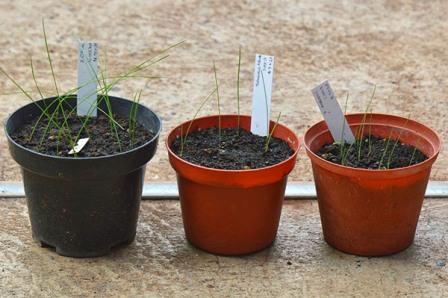

Propagation by daughter bulbs
Breeding zephyranthes indoors is as easy as shelling pears. The mother's bulb gives up to 15 babies, which are easily separated from it. Places of separation should be sprinkled with charcoal and the bulbs should be transplanted into a separate pot. If the bulb is tall, the neck can be left slightly above ground level. Flowers from small children bloom the next year.
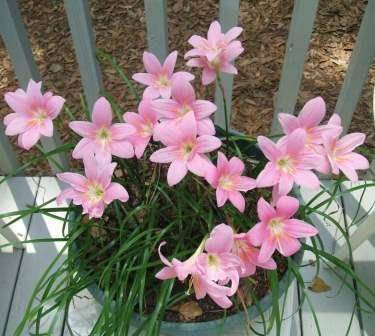

Hello Irina! It is difficult to say for sure whether the transplant was the cause of wilting and falling leaves in your zephyranthes (upstart). Of course, it is quite possible that you transplanted the flower incorrectly, violating the integrity of its roots, or choosing the wrong earthen mixture for it, or excessively moistening the earthen lump and the flower, unable to cope with new conditions for it, it just will not come to its senses from this transplant.
However, it is well known that marshmallows are capable of shedding their foliage during dormancy. In this case, the bulbs must be kept dry, and if the leaves still remain on the plant, then it is rarely necessary to water it - as a rule, 1-2 times a month is enough. So, your transplant could coincide with the dormant period of the flower. I think you should leave the flower alone for now - do not transplant it, do not over-water it, do not keep it in the bright sun. If possible, place it in a cooler room than usual. And maybe after some time the plant will come to life and start delighting you with its flowering.
As for the fact that even before the transplant, your zephyranthes did not bloom, being with you for a year already. In general, this flower is quite unpretentious and is able to bloom without much care from the owners. However, even such an unpretentious plant may have whims from time to time. It is clear that if a flower does not want to bloom in any way, then the conditions for its maintenance should be revised.
As a rule, a dry, cool and at the same time light wintering is the key to the future abundant flowering of zephyranthes. The flower feels better on the south, west and east windows. On the north window, it can also feel quite good, but it can be difficult to achieve flowering.
Also, sometimes the zephyranthes helps to bloom by stopping watering (this often happens during holidays), and then resuming watering again. In this case, the plant may decide that spring has come and the time has come for its flowering ...
If in warm seasons you have the opportunity to place zephyranthes on a balcony, veranda, or even in open ground, then this will benefit him. It can bloom on the street.
Regarding what kind of soil Zephyranthes prefers, what pests are affected, how often to water it and what is the best way to fertilize - you can easily find all this information on the Internet. For example, you can find detailed information on these issues at the following links on the web:
Zephyranthes breeding methods
The flower is propagated by daughter bulbs or seeds. The method of replanting annually with renewed bulbs is simpler and more affordable. When choosing this method, you can enjoy the flowering of the plant as early as next year.
Zephyranthes grown from seeds will bloom only after 2 - 3 years. But, if you choose this planting method, you should sow the seeds immediately after collection, in well-moistened soil. The seeds are not buried; a distance of at least 3 cm is left between them.


After sowing, the container is covered with foil or glass and placed in a room where the temperature does not drop below + 20 ° C. Usually shoots appear in a month. A hardened plant with a small bulb can be transplanted to a permanent place.
Pests
Often, zephyranthes suffers from the scabbard. If small brown spots are visible on the leaves, then the plant is affected by a pest. The leaves on which the scale insect settles, like the flowers themselves, will wither over time.
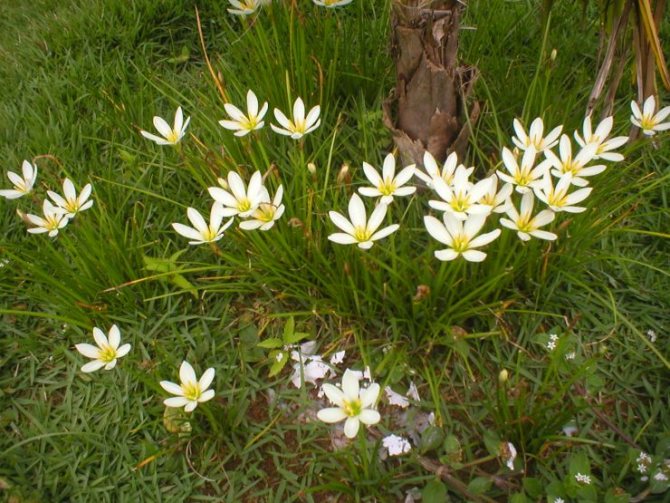

It doesn't take a lot of effort to get rid of the pest. It is enough to use special preparations, or wipe the affected areas several times with a 15 percent solution of insecticide
Photo of Zephyranthes
Testimonials
The plant is not capricious, it only requires watering, it should be watered moderately once a week or a little bit twice a week. Leaving is, in principle, simple, the maximum that is needed is to remove the yellowed stems, and periodically loosen the earth. I transplant it twice a year, in autumn and spring, next spring I will divide the bush, as it has grown very much for me. It blooms beautifully, I like it very much, such lovely bells, the color is delicate, white, and the flowers themselves are very delicate, it's a pity that they only bloom quickly, they bloom for a maximum of two days, but the flowers appear every day, so it's not a problem, and always you can preserve this beauty in the photo.
MaryaHr88
White zephyranthes gives a lot of flowers, I threw them out one after another, the flowers are large, delicate, only it is a pity that they fade quickly. There is absolutely no fuss with him, the main thing is to transplant and plant on time.
maryahramlyuk
Between flowering periods, Zephyranthes Lindley looks not at all remarkable: narrow long leaves and nothing else. As soon as it begins to bloom, you cannot take your eyes off the plant. It's easy to look after him. The plant reproduces by bulbs.
Natatka
Reproduction of culture
The easiest way to propagate a flower is by dividing the bush. To do this, it is removed from the soil in the spring and the root system is shaken off the ground.
We examine the bulbs, discard the missing ones, divide the rest into 2-3 bushes and plant them in new containers.
To propagate by seeds is impractical, since too much time passes before flowering.
Zephyranthes has strong immunity to a variety of diseases. It can only be destroyed by a constant flood of cold water or, conversely, with a prolonged drought.
Solving cultivation problems
Table: common care mistakes
| Error | Effects | Recommendations |
| Excess watering | Rotting bulb and roots | Water after the topsoil dries out |
| Insufficient watering | Withering or yellowing of leaves, no peduncles | Prevent the earthen coma from drying out |
| Bowl too big | Lack of flowering | You need to create a moderate tightness for the plant. |
| Peace is not guaranteed | Three months in autumn or winter, a flower definitely needs peace. | |
| The neck of the bulb is covered with earth | Observe the landing rules |
Table: Zephyranthes diseases and pests
| Name | Description | Methods of control and prevention |
| Amaryllis bug | Small insect, causes yellowing, dropping, wilting of leaves. |
|
| Spider mite | A small insect, entangles the leaves and stems with cobwebs, causing the leaves to dry out and the death of the plant. |
|
| Soft false shield | A convex insect 4 mm long, feeds on plant juices, causing its death. It is difficult to fight with insecticides, since the shield has protection - a shield on the back. |
|
| Whitefly | Small white insect 3 mm in size, similar to a moth. The whitefly comes from tropical countries, so it loves places where it is warm and humid. They live mainly on the underside of the leaves. |
|
| Fusarium (red rot) | This dangerous disease is caused by a fungus that penetrates the wounds and cracks in the bulb. It is manifested by rotting of the roots of the bulb, yellowing and wilting of the leaves. |
|
Photo gallery: diseases and pests that can infect marshmallows
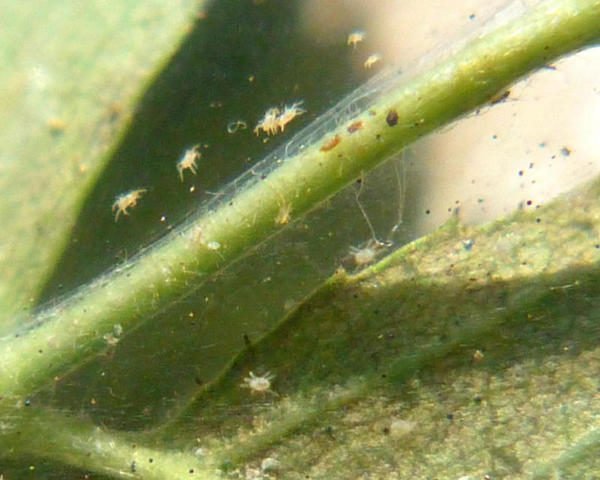

Spider mites appear when the air in the room is too dry
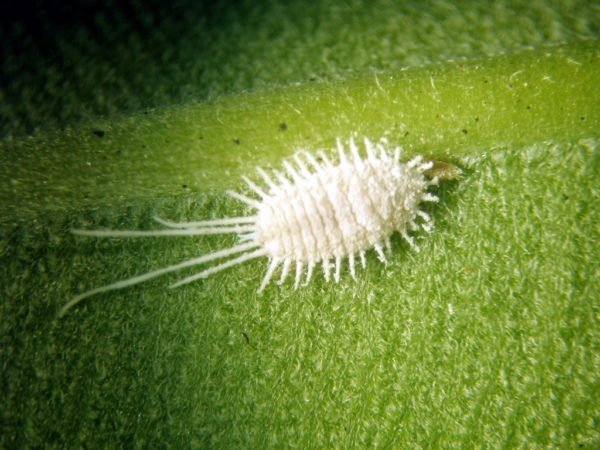

Amaryllis bug lives on bulbous scales
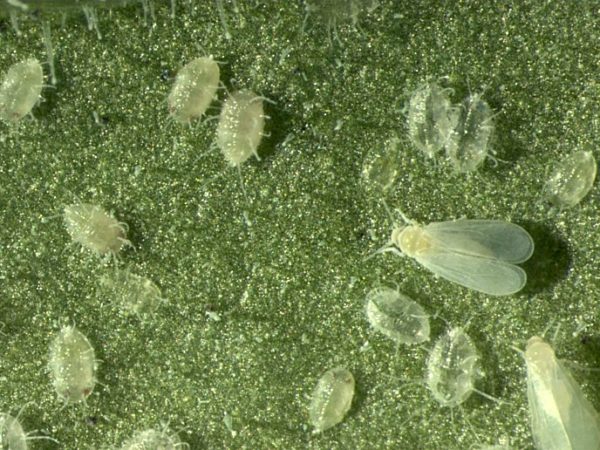

Whitefly appears in humid warm climates
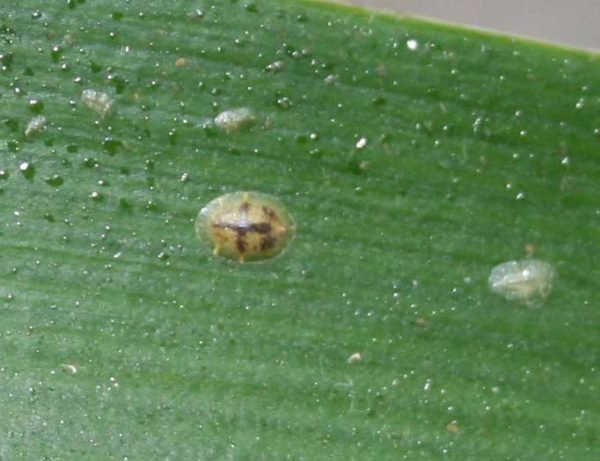

False shield is capable of very fast reproduction.


Fusarium is a dangerous fungal disease that causes rotting of the bulb and roots
Due to the fact that the zephyranthes bulbs are poisonous, the plant is quite resistant to disease and often dies due to improper care. In rare cases, zephyranthes can develop fusarium disease.
Common varieties for home cultivation
Florists prefer the following varieties and varieties of zephyranthes for growing at home:
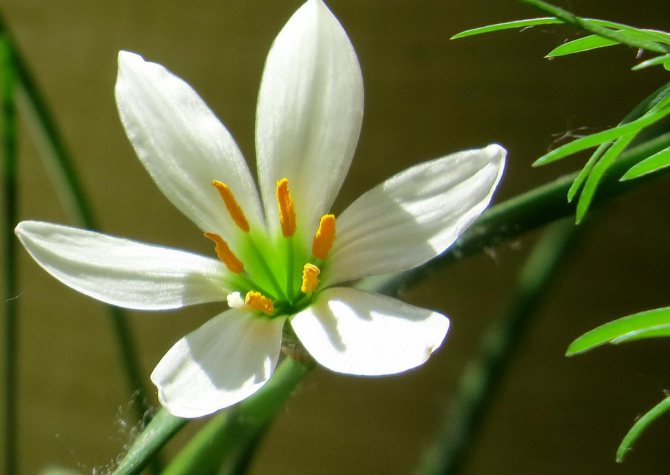

Zephyranthes white - leaf plates reach 50 cm in length, funnel-shaped flowers, white. The flower diameter is 6-8 cm, mainly the flowering period occurs in July-October.
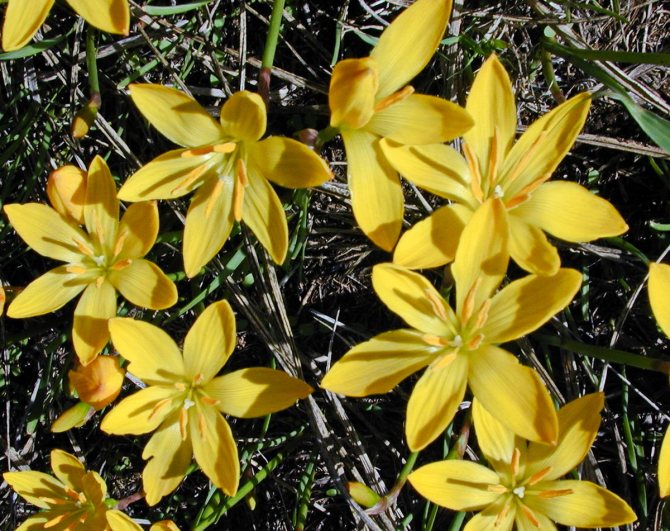

Golden - leaf plates reach 35 cm, their width is slightly more than 1 cm. The diameter of flowers is 7-9 cm, and the flowering period mainly falls on December-January.
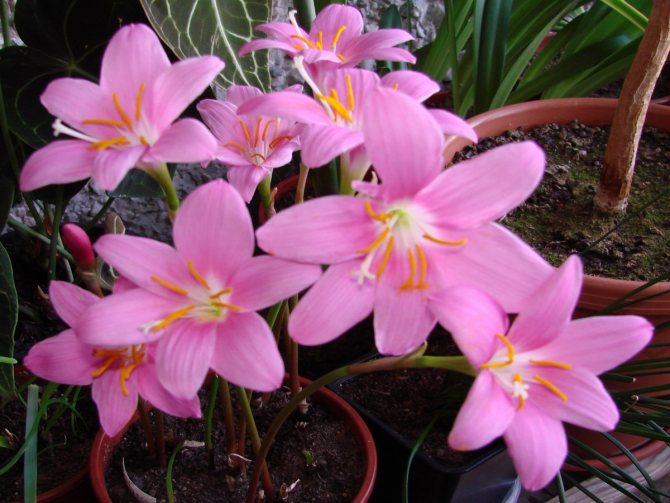

Large-flowered - the bulbs are large - up to 5 cm at the cut, the leaf plates reach a length of 40 cm, the peduncle is stretched to a maximum of 35 cm, and the flowers are pinkish, their diameter is up to 10 cm. The stamens are orange. The flowering period is in April-June.
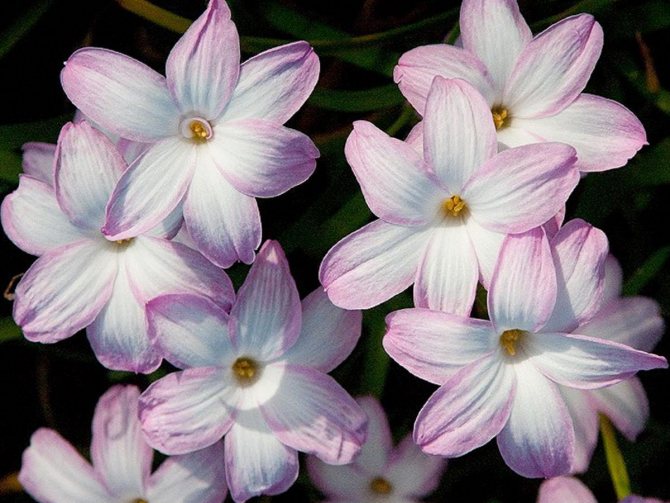

Pink - the maximum "growth" of a perennial is 20 cm, the leaf plates are glossy, and the flowers are light pink.
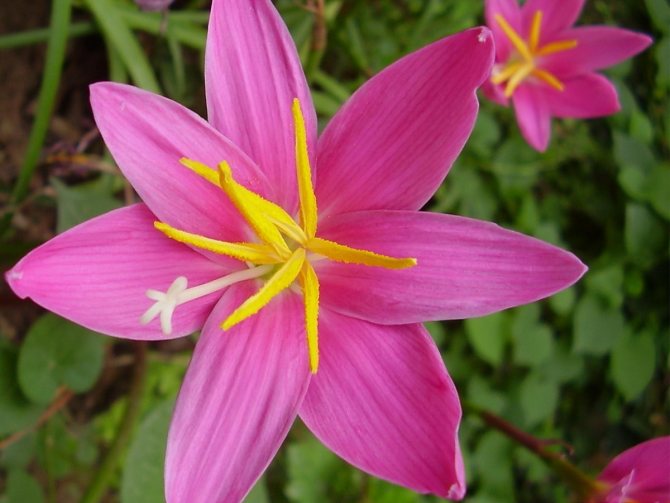

Powerful, otherwise - powerful pink - leaf plates are narrow, their maximum length is 30 cm.The peduncle is stretched by 20 cm, and the diameter of intense pink flowers is 6 cm.
These varieties are quite picky, which makes zephyranthes and home care for him feasible even for novice growers and amateur flower growers.
Transplant timing
Like all indoor plants, the rain flower is no exception, so the planned transplant is best done in the spring. Since the plants are actively growing and the mistakes made during transplantation, the flower will easily overcome. If he needs to make an emergency transplant, then it can be done within a year. It's just that in winter it is necessary to organize the correct temperature regime and highlighting with special lamps up to 8 hours of daylight hours.
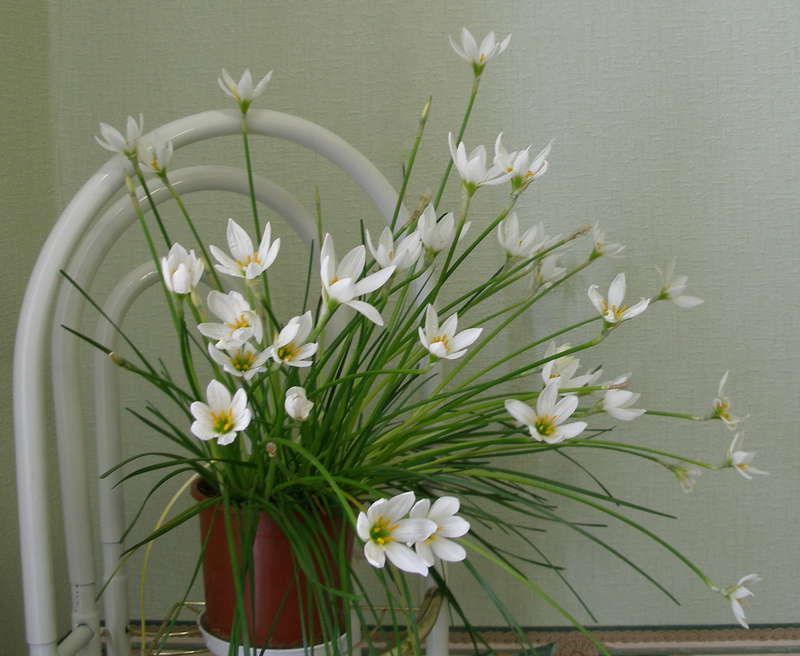

Name
Zephyranthes belongs to the genus of bulbous perennials and the amaralis family. Zephyranthes received several popular names - the flower of the west wind, upstart or rain lily. This is due to the fact that with the arrival of the rainy season, the flower rapidly throws out arrows, on which lily flowers bloom right before our eyes. But it waits out a drought in the ground.
Zephyranthes in translation is the flower of Zephyr, the god of the warm wind from the west, because it blooms precisely during the period of the west wind and the rainy season.
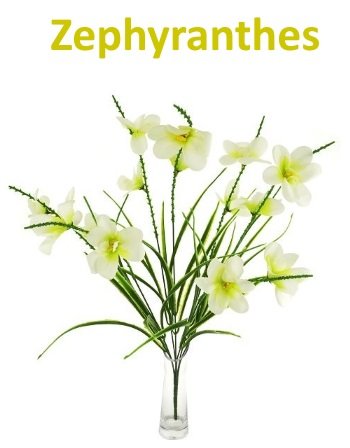

Zephyranthes
Signs and superstitions
There are no obstacles to growing zephyranthes at home. An upstart flower cannot be kept at home if one-year-old children live there, who taste everything. The plant has only positive energy, which helps to overcome the grower and household:
- timidity;
- stiffness;
- tightness.
The family that grows this plant will have strong family ties.
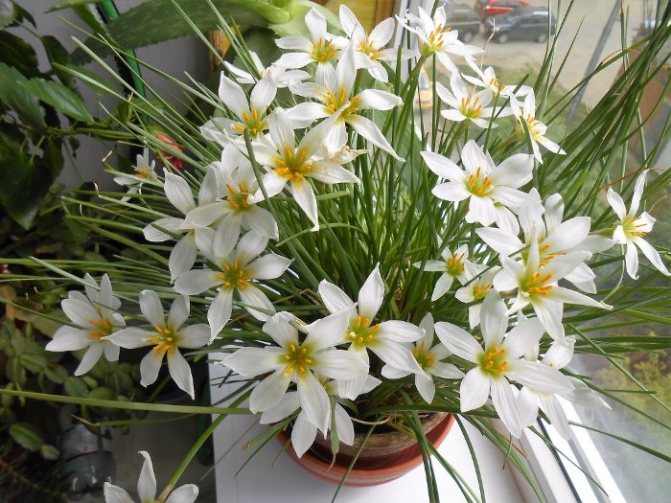

Agricultural technology for growing zephyranthes: secrets and nuances of outdoor care
Caring for zephyranthes is not difficult, even an inexperienced gardener or florist can handle the simplest steps. The main thing is to pay due attention to this exotic and thermophilic plant, water it in time and dig up the bulbs in time.
- Watering. Zephyranthes begins to release flower stalks only after abundant watering or after heavy rains. Therefore, watering is an important part of flower care. Watering should be done regularly, but in moderation, as over-watering there is a risk of flooding and rotting of the bulbs. For watering, it is recommended to use only warm and settled water and water only at the root. The regulator of the irrigation regime should be slightly moist soil. If the plant sheds leaves during dormancy, then it is better to stop watering.
- Loosening. It is important to loosen the soil around the plant immediately after planting the bulbs or after applying water under the root, but this must be done very carefully so as not to damage the bulbs.
- Top dressing of zephyranthes. For abundant and constant flowering, zephyranthes must be fed. To do this, use full complex mineral fertilizers and use them only at the beginning of flowering.
- Cleaning and storage of bulbs. It is recommended to dig up the bulbs of zephyranthes in the fall before the onset of frost. It is not necessary to immediately remove the leaves, it is necessary to temporarily put the dug out bulbs with leaves to dry. Only then can they be cleaned. Zephyranthes bulbs must be stored in dry boxes, you can sprinkle them with dry sawdust. Planting material is stored until spring at room temperature. However, some varieties of Zephyranthes can be carefully dug up and transplanted into flower pots. Thus, the plant will delight you even in winter. For this, for example, Zephyranthes white is suitable.
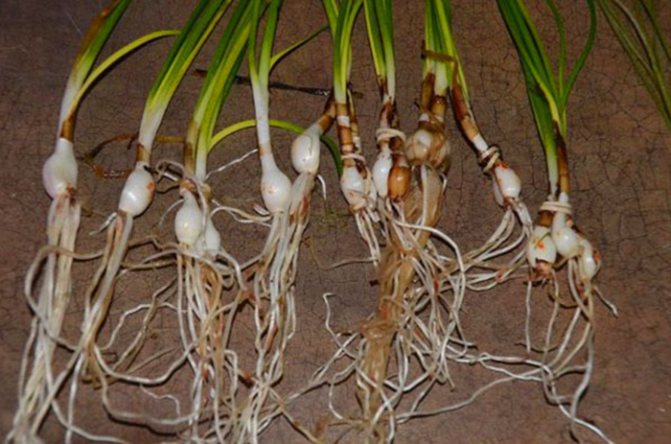

- Disease and pest control. Most often, this plant is affected by the scale insect, which feeds on its juice. Their activity leads to drying and curling of leaves and withering of buds. To combat this pest, you can use Karbofos. Another pest is a spider mite that infects leaves. A soap solution can be used to combat it. They need to process all the leaves, and then rinse with plain warm water.
Origin and description of the species
Zephyranthes is a genus of perennial bulbous plants that belongs to the amaryllidaceae family and has about 90 species, including hybrid varieties suitable for indoor and outdoor use. This amazing flower grows in humid places, swamps and peatlands of tropical regions of Central and South America, Mexico, Argentina, Brazil, Paraguay and the West Indies. Locals are happy to cultivate it on plots near their homes.
Zephyranthes have several "popular" names: upstart, flower of the west wind, rain lily. The thing is that, as soon as the rainy season begins, the zephyranthes who had been dozing before suddenly suddenly shoots arrows, crowned with flowers that look like lilies, which bloom literally before our eyes. The upstart bloom begins unexpectedly and lasts a very short time - on average, 2 days.The plant got its official name, which literally translates as the flower of Zephyr, due to the fact that the period of its growing season and flowering falls on the appearance of the westerly winds (Zephyr is the god of the warm westerly breeze).
Flowers in zephyranthes are crocus-shaped, wide open, with stamens of equal length. The color of the petals can be different - from white to purple. Zephyrantheses look best in a group consisting of a large number of planted onions. In moments of drought, plants are dormant, without leaves and shoots.
Zephyranthes has a "brother" - the gabrantus, which is also called the Argentine rain lily. How not to get confused?
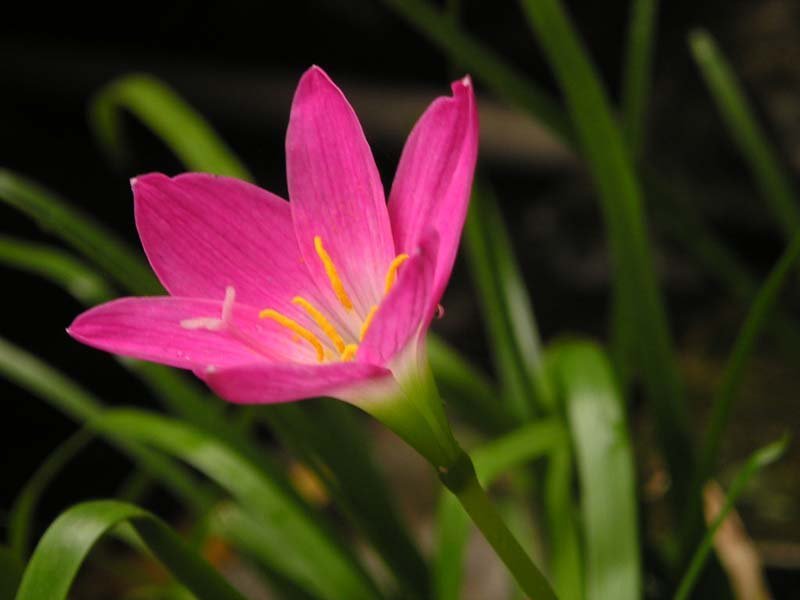

Zephyranthes peduncle is always crowned with only one erect flower
Table: Differences Between Zephyranthes and Gabranthus
| Zephyranthes | Gabrantus |
| Flowers open wide | Lily flowers, petals form a tube at the base |
| Erect flowers | Flowers are inclined to the stem at an angle |
| The stamens are all the same length | Filaments of different lengths |
| Seeds are flattened, wingless | Seeds are thickened, slightly winged |
| There is one flower on the arrow | One peduncle can be crowned with up to four flowers |
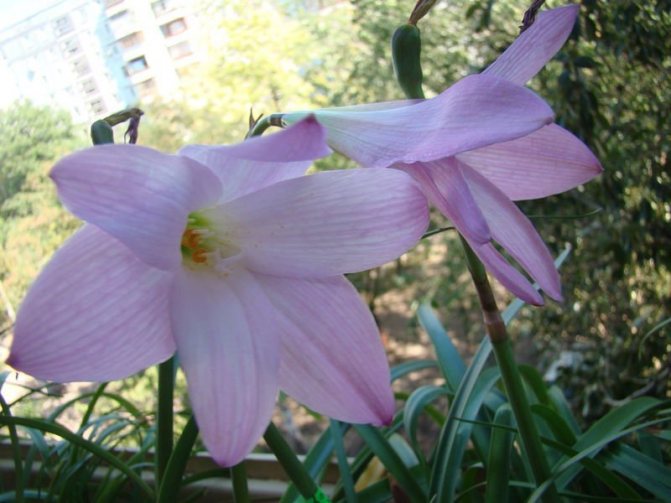

The peduncle of the gabrantus can be decorated with from one to four flowers, inclined to the stem
At first, Gabrantus belonged to the genus Zephyranthes, but since there are enough differences between these plants, it was singled out as a separate genus. Zephyranthes and gabrantus belong to the amarylissa family.
Upstart flower: why you can not plant at home
There is an opinion that the upstart flower is far from the plant that should be kept in the apartment. It's all about folk signs. Despite the fact that this is a very beautiful and delicate flower, some people are afraid to plant it in their home. What is the reason for this?
Firstly, the Chinese doctrine of feng shui says that it is undesirable to keep zephyranthes in the house, since this plant has pointed needle-like leaves and petals. According to feng shui, it is recommended to choose flowers with rounded leaves for the house. For those who nevertheless intend to grow rain lilies at home, the doctrine advises keeping them in the living room or in the study. Zephyranthes is not suitable for the bedroom in any case.
Secondly, florists came up with the restriction on the content of an upstart flower in an apartment. Unlike other flowers, marshmallows do not attract pests in any way. Insects do not fly to this flower, and if a person tries the leaves of marshmallow, then he can get sick. Thus, florists consider it to be to some extent a poisonous plant, which has no place in an apartment. There are no more restrictions on the content of zephyranthes in the apartment. Many people like this flower, and they are happy to decorate their apartment with it, or they grow it in the city.
How to water and feed
When the growing season and flowering are in the active phase, watering is carried out regularly, but without moisture stagnation, from which the bulbs rot. With the advent of a dormant period at the upstart, it is enough to water a little every 15 days. In fresh plantings, watering is rare so that the bulbs do not rot.
Fertilizing a rain lily will be required from the beginning of flowering until it ends. The frequency of application is every 2 weeks. Liquid complex fertilizer is optimal.
The plant is demanding on air humidity and must be supported by spraying.
Description
The flower of zephyranthes is perennial; for indoor cultivation, you can choose one or more of ten species.
Roots in the form of brown round or oblong bulbs up to 3.5-5 cm in diameter, covered with scales. The rosette grows from the root collar above the soil. Green leaves up to 35-50 cm long resemble straps (very rarely hollow tubes).
The flowers are similar to crocuses, the color of different varieties is different. The peduncle has one flower, consisting of six wide-open, slightly pointed, petals. The lifespan is no more than 7 days.
In Russia, zephyranthes are bred indoors, sometimes they are transplanted outside for the summer. During drought, the aboveground part dries up, dies off, the bulb is at rest until conditions improve.
Homemade daffodil has healing properties. Funds based on it are used to treat colds, tuberculosis, cancer, stabilize blood sugar levels.
Home care
The optimal place for the location of the flower in the house will be windows to the west or east. Zephyranthes must be constantly lit.
During the period of active development, the temperature of the content is 18-26 °, and during dormancy in autumn and winter, 10-12 ° is recommended. The upstart needs soft light. In summer, zephyranthes will grow well on a loggia or in a garden in a sunny area.
For planting a flower of the west wind, nutritious and airy soil with an admixture of river sand is needed. The acidity level is pH neutral. The substrate is independently prepared from turf, humus and sand. Then add a small amount of phosphate fertilizer.
When planted in open ground, a large bulb manages to form during the season - a guarantee of luxurious flowering next year. Garden species should be stored for winter storage. Bulbs die from subzero temperatures.
Zephyranthes are transplanted annually or every other year in the spring or fall. The plant quickly forms young bulbs and, if not transplanted, they fill the entire pot, which is bad for the flower.
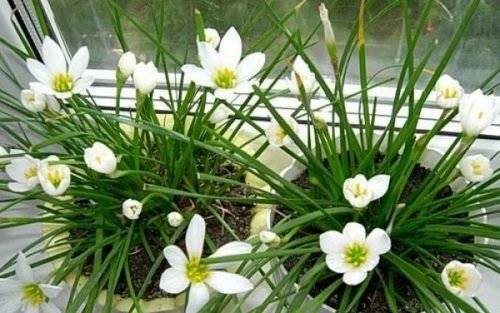

Reproduction
For propagation of upstarts, daughter bulbs and rarely seeds are used. The division procedure is planned at the end of the season, before the resting phase. On an adult bulb, 10-15 children ripen, which are separated for planting in an independent container.
6-12 pieces are placed in one wide and shallow flowerpot to get a lush bush. Necessarily need drainage and pieces of brick or expanded clay. Varieties with a short neck are completely buried, and the long one should rise above the ground. The flowering of young plants will come next year.
Watch also a video on the topic:
Tips for those looking to buy Zephyranthes
An upstart flower can be easily purchased at any specialty store. No special knowledge is required for this: choose a sturdy, beautiful flower with clean leaves and intact stems.
It is advisable to choose an instance with barely blossoming buds so that it delights you with its flowering as long as possible. However, this is not necessary: any purchased zephyranthes may well bloom in your home soon after purchase.
To know when to expect the long-awaited appearance of flowers, consult with the seller: find out what kind of species it is - what time of year it blooms and whether it sheds leaves after that. Thus, you will be able to provide the flower with optimal care that meets its requirements (after all, they are different for each species), and you will not needlessly worry about the natural fall of leaves.
The marshmallow of your choice may need to prune the leaves before the dormant period - this can contribute to better flowering, but not all members of the species require such measures.
The upstart houseplant is not very fond of frequent transplants, so if the store pot currently matches the size of the flower, do not rush to move the plant to another.
Prices for an adult flower start at 100 rubles. Further, it all depends on the rarity of the type and size of the flower.

